IMAP (Interstellar Mapping and Acceleration Probe)
Non-EO
NASA
Astronomy and Telescopes
Quick facts
Overview
| Mission type | Non-EO |
| Agency | NASA |
IMAP (Interstellar Mapping and Acceleration Probe)
Objectives And Observations Spacecraft Launch Sensor Complement Development Status References
NASA has selected a science mission planned for launch in 2025 that will sample, analyze, and map particles streaming to Earth from the edges of interstellar space. The IMAP mission will help researchers better understand the boundary of the heliosphere, a sort of magnetic bubble surrounding and protecting our solar system. This region is where the constant flow of particles from our Sun, called the solar wind, collides with material from the rest of the galaxy. This collision limits the amount of harmful cosmic radiation entering the heliosphere. IMAP will collect and analyze particles that make it through. 1)
"This boundary is where our Sun does a great deal to protect us. IMAP is critical to broadening our understanding of how this ‘cosmic filter' works," said Dennis Andrucyk, deputy associate administrator for NASA's Science Mission Directorate in Washington. "The implications of this research could reach well beyond the consideration of Earthly impacts as we look to send humans into deep space."
Another objective of the mission is to learn more about the generation of cosmic rays in the heliosphere. Cosmic rays created locally and from the galaxy and beyond affect human explorers in space and can harm technological systems, and likely play a role in the presence of life itself in the universe.
The spacecraft will be positioned about 1.5 million kilometers away from Earth towards the Sun at what is called the first Lagrange point or L1. This will allow the probe to maximize use of its instruments to monitor the interactions between solar wind and the interstellar medium in the outer solar system.
The mission's principal investigator is David McComas of Princeton University. The JHU/APL (Johns Hopkins University/Applied Physics Laboratory) in Laurel, Maryland, will provide project management. The mission will carry 10 science instruments provided by international and domestic research organizations and universities.
IMAP was selected following an extensive and competitive peer review of proposals submitted in late 2017. The mission is cost-capped at $492 million, excluding cost for the launch vehicle.
This is the fifth mission in NASA's STP (Solar Terrestrial Probes) Program portfolio. Others include the Solar Terrestrial Relations Observatory (STEREO), a collaboration with ESA (European Space Agency) that enabled a global view of the Sun and inner heliosphere; the Magnetospheric Multiscale (MMS) mission currently investigating the fundamental process of magnetic reconnection near Earth; the solar remote sensing mission Hinode, an ongoing collaboration with the Japan Aerospace Exploration Agency; and the Thermosphere, Ionosphere, Mesosphere Energetics and Dynamics (TIMED), a mission observing the outermost layers of the Earth's atmosphere.
The Heliophysics Program Office at NASA's Goddard Space Flight Center in Greenbelt, Maryland, manages the STP Program for the agency's Heliophysics Division in Washington. NASA's heliophysics missions seek to understand the Sun, and its interaction with the Earth and the solar system out to the interstellar medium, including space weather.
In June 2018, NASA selected SwRI (Southwest Research Institute) to manage the payload and payload systems engineering for a new IMAP mission that will sample, analyze and map particles streaming to Earth from the edge of interstellar space. SwRI also will provide a scientific instrument and other technology for IMAP. 2)
Student Collaboration
The planned IMAP Student Collaboration augments the mission's science return, develops hands-on research experience for students, at least half of whom are women and/or members of underrepresented minorities, and contributes to diversifying space science. This program compliments the rest of the IMAP mission scientifically and provides students of diverse backgrounds with hands-on experience designing and building a CubeSat and two scientific instruments and with scientific involvement in studying the origin of EPs in the innermost magnetosphere.
Undergraduate, graduate, and high school students will design, develop, build, and launch a small satellite (a 6U CubeSat) with the science objective to determine how particles get injected into and accelerated in Earth's magnetosphere. This augments the fourth science objective of IMAP (O4) of "identifying and advancing understanding of particle injection and acceleration processes near the Sun, in the heliosphere, and in the heliosheath." The students will analyze the measurements of the CubeSat in combination with observations by IMAP and the rest of NASA's HSO to determine the relative importance of particles accelerated locally, particles accelerated in the corona and precipitating into the auroral regions,and particles accelerated at Earth's bow shock.
The IMC (IMAP Magnetospheric CubeSat) and instruments will be designed, developed, built, and operated by students at the IMAP student collaboration institutions, which include UNH (University of New Hampshire), University of Colorado at Boulder (CU), Howard University (HU), a Historically Black College and University, and in partnership with chapters of the Society of Women Engineers at UNH and CU. Other participating institutions include APL (Applied Physics Laboratory), Morgan State University, and DC-area and female only high-schools. The inclusion of more partners will be pursued in Phase A to work on joint investigations with IMAP and IMC. The IMC carries two student-built instruments: (1) REPTile2, an EP (Energetic Particle) detector (proton and electron)built at CU to detect injection and loss of EPs in Earth's magnetosphere and (2) an ESA (Electro Static Aanalyzer) built at UNH to determine the low-energy population of protons and positive ions in the inner magnetosphere.
Heliophysics Future Leaders (HFL) Program
To help address the ongoing lack of diversity in Heliophysics instrument and mission leadership, we look to the future and seek ways to develop and promote a far more diverse set of future leaders. IMAP science mentors pair with a set of diverse and high-achieving graduate students and postdocs throughout the IMAP mission development and science phases. HFL participants are chosen from a highly qualified pool of students and early career scientists identified both by team members and through solicitation of nearby colleges, especially those serving underrepresented groups.
Mentors help HFLs to understand mission design principles, requirements, and how to address relevant scientific topics in their particular areas of involvement. Five to ten future leaders comprise a peer cohort big enough to support each other in addition to the support given by the IMAP team. HFLs attend IMAP team meetings and are expected to present the work that they have been doing with their mentor. Specific skills that HFLs develop also include communication, both verbal and written, as well as time management, scientific team building, and networking.
Objectives And Observations
IMAP directly addresses and provides closure on four critical science objectives, ordered here from outside the heliosphere inward (without priority):
(O1)->Improve understanding of the composition and properties of the LISM (Local Inter-Stellar Medium)
(O2)->Advance understanding of the temporal and spatial evolution of the boundary region in which the solar wind and the interstellar medium interact.
(O3)->Identify and advance understanding of processes related to the interactions of the magnetic field of the Sun and the LISM.
(O4)->Identify and advance understanding of particle injection and acceleration processes near the Sun, in the heliosphere and heliosheath.
The complete and coordinated observations from the IMAP suite enable fundamental insights through three levels of study. First, IMAP allows us to discover global properties of the interstellar interaction as a coupled system, including the origins of particle acceleration directly from IMAP data products. Second, IMAP helps us explore global fundamental properties of the interstellar interactions and origins of particle acceleration using IMAP data products, simple physics-based calculations, theory, and limited 2D and 3D modeling. Finally, IMAP lets us understand in depth the global properties of the interstellar interactions and the origin of particle acceleration through interactive analyses using IMAP data products to define and refine advanced models and simulations. 3)
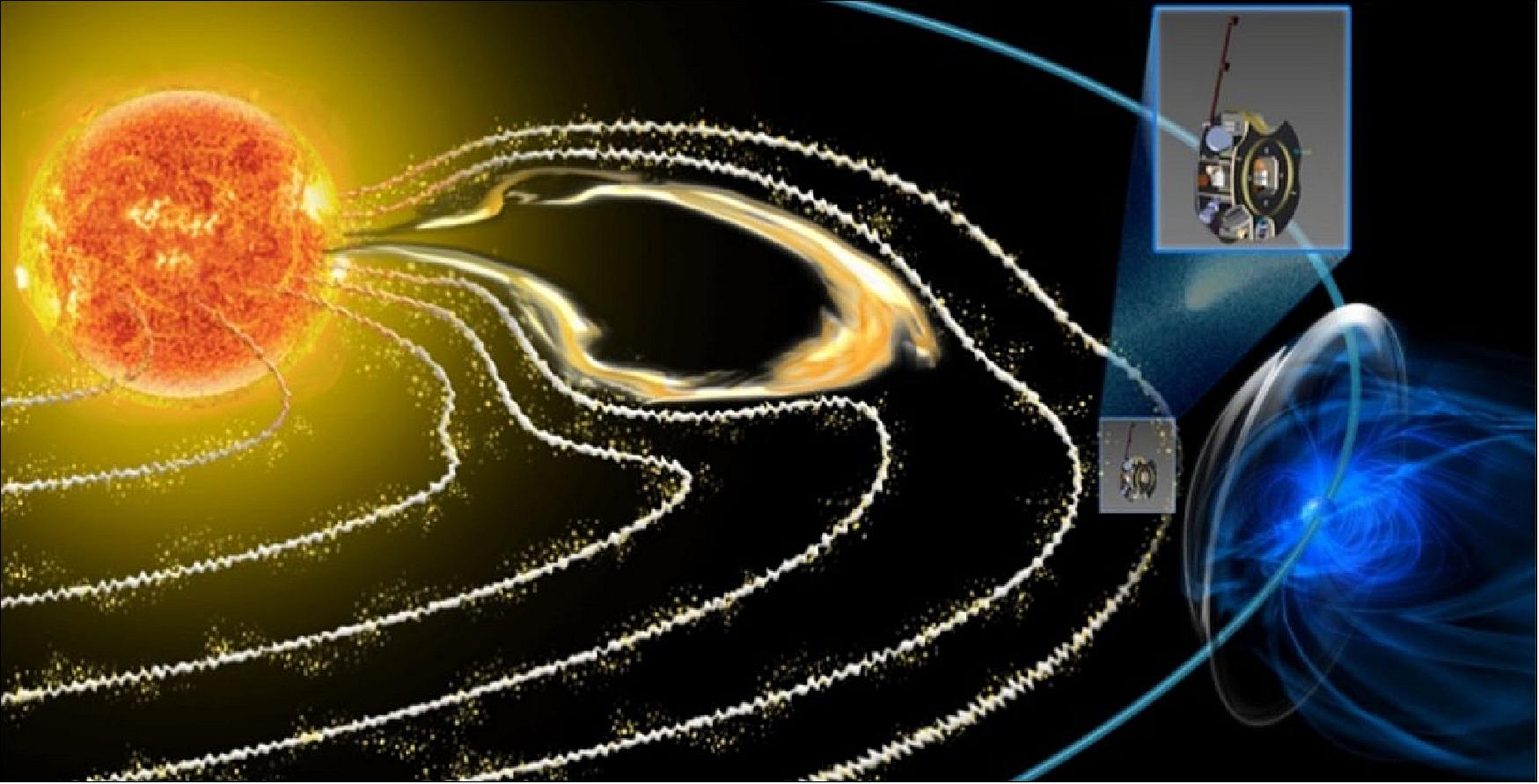
Our IMAP investigation also incorporates robust theory and modeling (T&M) to gain detailed insight into the global properties of the heliosphere, the Ribbon and Belt, and particle acceleration. The IMAP T&M team includes Co-Is specifically tasked to ensure deep investigation of (1) the origins of particle acceleration in suprathermal populations, (2) the roles of turbulence in microphysical processes, and (3) kinetic interactions across scales in shocks, interaction and reconnection regions at 1 AU, out through the solar wind and into the heliosheath. These T&M activities connect IMAP's in situ and remote observations, enabling tests of wide-ranging theories through the heliosphere, and closure for open questions at the heart of IMAP. IMAP measurements and T&M span poorly understood suprathermal particle populations, complementing other HSO (Heliophysics System Observatory) missions without expending significant resources to duplicate HSO measurements, as described below.
The four IMAP science objectives lead to five overarching observational drivers:
1) High-sensitivity global heliospheric imaging;
2) ENA energy spectra covering core solar wind through EPs;
3) Neutral H, He, O, Ne, and D fluxes and flow direction as a function of time of year;
4) High-time-resolution (< 1 min) PUI (Pickup Ion), STs (Suprathermal Ions), and energetic ion measurements;
5) Complete solar wind electron, proton, heavy ion, and magnetic field measurements to resolve solar wind structures, CMEs (Coronal Mass Ejections), shocks, and kinetic substructures.
Measurements of ISD (Interstellar Dust), UV glow maps reflecting combined primary and secondary populations of H and He, and the latitudinal structure of solar wind provide supporting context. These complementary and synergetic observations are required to address fully the four mission science objectives. The following four subsections describe our IMAP mission's approach to achieving each of the four science Objectives in more detail.
LISM (Local Inter-Stellar Medium) Properties and Composition (O1)
IMAP observations will allow us to precisely derive the interstellar flow parameters (i.e., interstellar He flow speed and temperature better than ~2% accuracy, as well as the flow direction) to determine the external boundary condition of the global heliosphere. IMAP provides precise measurements of ISN (Interstellar Neutral) He, O, and H to specify the ram pressure of interstellar flow, its Mach number, to meaningfully differentiate the flow parameters of O, He, Ne, and H, and to define accurately the critical BIS–VISN plane, which organizes the heliosphere structure and topology. Precise measurements of LISM flow properties from IMAP make it possible to provide:
• the first determination of outer heliosheath properties that influence our understanding of all secondary neutral populations,
• the fundamental physical mechanisms by which the interstellar medium interacts with the solar wind outflow including interstellar flow around the heliopause,
• the charge-exchange coupling with neutral populations within the outer heliosheath, and
• the physical processes controlling interactions with the interstellar magnetic field.
Ultimately, IMAP's precise measurements are critical for establishing how the interstellar flow interacts with and influences global heliospheric structure, which feeds into objectives O1 and O2.
Current uncertainties prevent accurate determination of the interstellar boundaries. For instance, ~10% uncertainty in speed translates to ~20% in interstellar ram pressure. Thus, it is not certain if there is a bow wave or shock ahead of the heliosphere and there are even wide error bars on the orientation of the heliospheric symmetry plane. When viewing the interstellar flow from a fixed vantage point (e.g., IBEX-Lo FOV (Field of View) body fixed perpendicular to spin axis), there is a fixed peak longitude of the observed distribution, which produces an analytic relationship between interstellar flow speed and interstellar ecliptic longitude (referred to as a parameter tube). On IMAP-Lo, the pivot platform allows for viewing from widely separated vantage points (across > 180º in ecliptic longitude) and therefore produces an array of intersecting parameter tubes, which determine precisely the interstellar speed and flow longitude. The width of the ISN spin-phase distribution is used to determine the interstellar temperature while the peak of the spin-phase distribution also determines the interstellar ecliptic inflow latitude.
IMAP will derive the O and H flow speed to better than 5% accuracy, a significant improvement over the ~20% accuracy provided by IBEX-Lo. The accurate determination of H, He, and O flow properties is fundamental for IMAP to resolve the effects of filtration and whether the interstellar medium is isothermal or instead strongly influenced by turbulence. This advance is essential for understanding the kinetic properties of the local interstellar flow that controls how the interstellar medium physically interacts with the solar wind at the heliopause. IMAP enables a more detailed understanding of the interstellar conditions, which is equally critical in determining how the Ribbon and Belt form in the LISM and is associated with objective O3. Precise determination of the ISN parameters and the secondary components provides tight constraints on the ionization state of the LISM.
The LISM is the only locally accessible sample of extrasolar material and thus provides the state of galactic matter today in juxtaposition to solar material from 4.5 billion years ago. It therefore provides us with critical insight into Big Bang nucleosynthesis and the galactic evolution in our neighborhood, which is representative of the galactic habitable zone. Measurements of 3He+/4He+ from PUIs and D/H from ISN atoms are key observations for Big Bang nucleosynthesis, with 3He+/4He+ thus far observed to only ±20% and there are no in situ D/H observations. However, a first determination of D/H in the LISM was accomplished with IBEX. Interstellar D/H is a powerful probe of nucleosynthesis and the chemical evolution of the MilkyWay galaxy , yet observations in the interstellar medium are scarce and line-of-sight integrated and ionization levels of interstellar atoms may vary significantly between the heliosphere edge and interior of the surrounding interstellar cloud. The D/H ratio provides input on stellar evolution, and its contribution to the local matter inventory and the Ne/O ratio has ramifications on the balance between volatile and refractory elements, which requires observation of gas phase and dust composition in the LISM.
IMAP will provide the LISM composition measurements needed to move beyond qualitative constraints and include the first detailed abundance information from direct ISN matter. For D/H, this will be to better than 20% accuracy, ISN Ne/O to better than 10% accuracy, 3He+/4He+ PUI abundance to better than 10% accuracy, and 22Ne+/20Ne+ PUI abundance to better than 30% accuracy. The first accurate interstellar Ne/O abundance ratio from IMAP will test the existence of an oxygen deficit in the local galactic medium due to preferential processing of O on grains. IMAP PUI abundance information (i.e., 22Ne+/20Ne+, 3He+/4He+) specifies LISM isotopic properties key to galactic evolution and nucleosynthesis models.
IMAP also provides the first accurate in situ measurements of the flux, size distribution, and composition of ISD particles flowing through our solar system. IMAP will provide detailed composition measurements (mass resolution m/Δm > 200) of 100 particles per year based on Ulysses-derived fluxes to fill a significant knowledge gap in our current limited compositional measurements of ISD particles. The Cassini Cosmic Dust Analyzer (CDA) orbiting Saturn found 36 ISD particles all with similar chemical makeup of magnesium rich silicate and oxide composition with iron inclusions. The Stardust mission returned even fewer (only 7) candidate ISD particles with diverse chemical composition, including sulfides in some of the particles that contradict the CDA results. The much higher IMAP observation rate provides an unparalleled opportunity to directly sample and thereby discover the chemical makeup of solid matter in our galactic environment with unmatched resolution and move beyond the limitations of these prior measurements.
Finally, IMAP incorporates detailed information of the UV glow from inflowing H and He. These observations provide complementary ionization and radiation pressure measurements (amplitude variations better than 5% accuracy) and solar wind measurements (resolving latitude variations better than 15° accuracy) needed to interpret the directly sampled ISN H, Ne, and O. Observations of the backscatter He glow informs on the solar wind electron temperature inside 1 AU at all heliolatitudes and constrains the electron ionization rate of ISN gas. These measurements provide complementary knowledge of ionization rates, which cull ISN atoms, thereby influencing the observed spatial and velocity distributions of ISN H, O, He, Ne, and D. Direct ionization rate measurements significantly improve our understanding of the ISN flow properties. Current knowledge of electron ionization rate inside 1 AU is only thought to be accurate to within an order of magnitude, but likely significantly attenuates the flux of the indirect beams of ISN atoms. The pivot platform will enable IMAP-Lo to observe also the indirect beam and thereby provide an independent measurement of the total ionization rates at least for He and Ne.
Structure and Evolution of Ribbon, Belt, Globally Distributed Flux (O2)
IBEX's ENA (Energetic Neutral Atom) sensors provided novel measurements that shaped our understanding of the heliosphere, while Cassini/INCA provided further insight with higher-energy ENA measurements. However, both IBEX and INCA (Ion and Neutral Camera) face challenges resolving the faint ENA emissions from the outer heliosphere. For example, Cassini observations were limited by Saturn's large ENA source region and the small amount of time spent outside of Saturn's magnetosphere. IMAP incorporates major advancements to overcome the challenges faced by IBEX and INCA, including an average improvement in collection power of ~15 x, ~25 x, and ~35 x for IMAP-Lo, IMAP-Hi, and IMAP-Ultra, respectively; introduction of a pivot platform to optimize sky viewing and measure the interstellar inflow for most of the year; and the ability to resolve temporal changes down to 3 months (IMAP-Lo and IMAP-Hi) and 1 week (IMAP-Ultra). These leaps in spatial and temporal resolution, and precise determinationof interstellar properties, yield unprecedented resolution of interstellar interactions.

IMAP resolves the temporal and spatial evolution of the Ribbon, the Belt, and interstellar boundary regions. IMAP provides high angular resolution (4°) global ENA maps from 1 to 70 keV (for estimated counting statistics) to resolve Ribbon-Belt spatial structure. IMAP also produces global maps extending down to 100 eV to cover the complete Ribbon-Belt ENA energy range, albeit at somewhat lower angular resolution. Finally, IMAP measures the complete ENA energy spectra (10 eV–100 keV) from larger, but distinct regions (e.g., nose, tail, flanks, poles, Ribbon, Belt) to define the morphology and evolution of heliosheath populations from the plasma core, to STs and EPs. Observations spanning this complete energy range are critical for establishing not only the origin of the Ribbon but also its relationship to the Belt.
IMAP also probes the evolution of the heliosphere on short, 3-month scales, to test for the existence of instabilities near the nose and heliopause, and possible rapid evolution of the Ribbon and Belt . These time-resolved measurements of the Ribbon, Belt, and other structures probe from the Ribbon and PUI populations up through suprathermal and EP energies. IMAP provides much higher collection power than previous observations, with ~15 x, ~25 x, ~ 35 x that of IBEX-Lo, IBEX-Hi, and INCA, for IMAP-Lo, IMAP-Hi, and IMAP-Ultra, respectively, on average (Figure 2).
Different Ribbon origin hypotheses predict different key observables, such as the global spatial geometry, global spectral properties, location relative to the Sun's motion through the LISM, and variability of the ENA emission intensity over space and time. In particular, for hypotheses in which the ENAs originate as solar wind ions, the temporal variability of ENA flux and its association with solar wind variation is emerging as a definitive test. A recent model highlights the need for high-angular-resolution measurements of the Ribbon. That model suggests that the Ribbon forms from the interaction of PUIs beyond the heliopause with preexisting interstellar turbulence via magnetic mirroring near BIS · r ~0 . This mechanism predicts that the Ribbon is double-peaked due to particle-wave interactions; this may be reflected in the possible fine structure seen in early IBEX observations (Figure 3). The existence of Ribbon fine structure (or a double-peak) is unconfirmed. The improved IMAP angular resolution (down to 4° for energies > 1 keV) is sufficient to discover fine structure associated with instabilities in ribbon and Belt formation, and potentially other heliosphere structures.
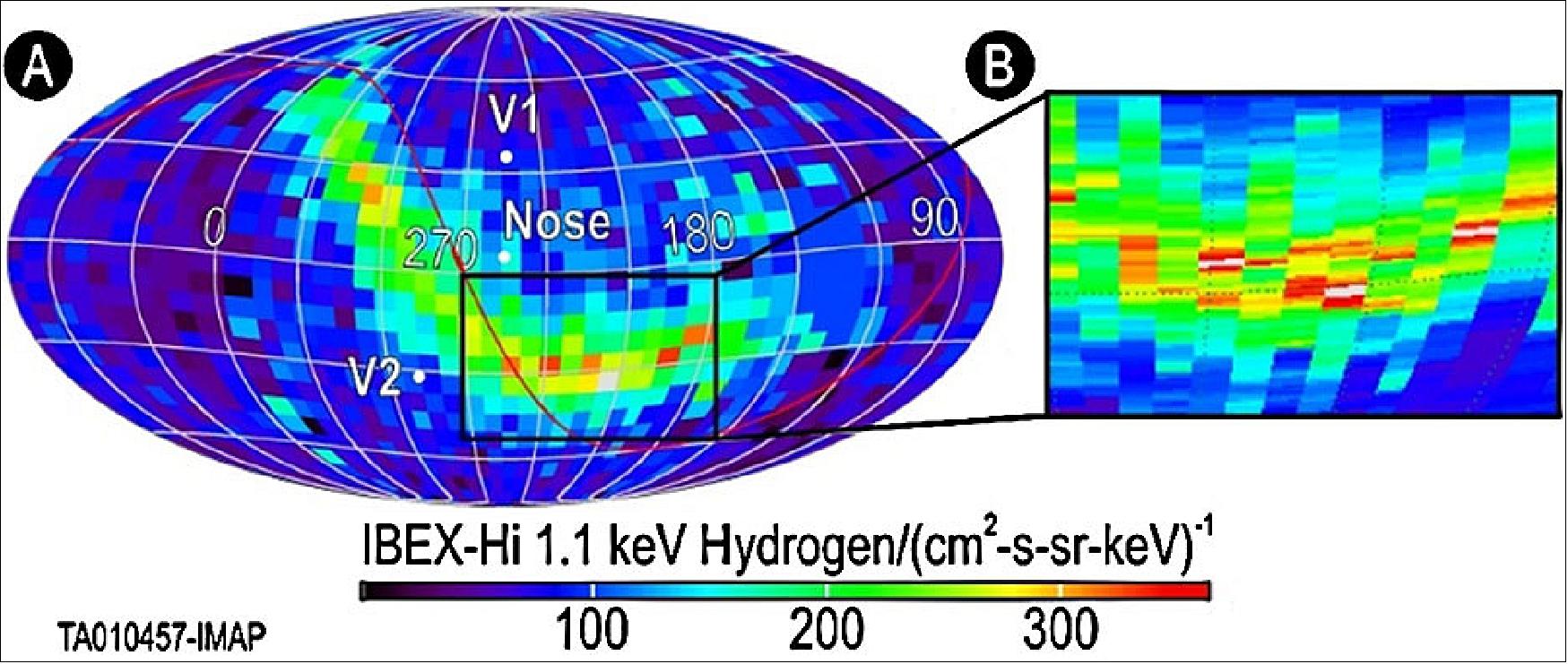
Physical Processes Regulating the Global Heliosphere (O3)
IMAP resolves how physical processes within the heliosheath control global heliospheric structures as well as the interactions among the solar wind, the local interstellar flow, and local interstellar magnetic field. The approach to this objective involves six synergistic sets of observations as follows.
ISN atom populations and PUIs reflect the external properties of the interstellar medium imposed as boundary conditions on the global heliosphere. With IMAP, we observe the primary ISN populations (H, He, O) to determine precise interstellar flow properties. These observations set the outer boundary conditions on the global heliosphere and regulate the heliosphere's interstellar interaction.
Energy partition between the various ENA populations is critical to determining the physical processes that regulate the heliosphere. With IMAP, we resolve the complete ENA energy spectrum by measuring ENA populations from core solar wind through PUI, STs, and EPs with statistical accuracy across the full energy range from 10 eV to 100 keV.
Heliospheric structures, and the resulting distributions of ENA emissions, evolve over time on various characteristic timescales (e.g., McComas et al. 2018; Zirnstein et al. 2018a). IMAP resolves the evolution of ENA fluxes down to six-month timescales to track the temporal evolution of the Ribbon, Belt, and heliospheric regions at energies down to 100 eV. These observations allow us to understand the temporal variability of global heliospheric structures.
Observations available from IBEX and INCA have not been sufficient to fully resolve the differences between the Ribbon and Belt and understand the connection between them. This lack of understanding further clouds the relationship between the different orientations of these two structures and how one or both reflect the external direction and strength of the interstellar magnetic field. On IMAP we resolve the Ribbon and Belt connection and direction and the strength of the interstellar magnetic field with a combination of high-angular-resolution ENA measurements (4°) spanning 100 eV to 70 keV and ENA energy distributions with lower angular resolution (to increase counting statistics) up to ~100 keV. These observations are taken by a suit of three instruments that are properly intercalibrated over overlapping energy ranges.
The charge-exchange process depletes the energetic protons in the heliotail and makes the interpretation of the heliotail structure difficult. With the ENA composition measurement from IMAP-Hi, we also observe ENAs of elements heavier than H. Lower charge-exchange rates for energetic He ions allows their penetration into more distant regions of the heliotail and the production of He ENAs will help expose the global heliotail structure.
Secondary neutral atom populations arise out of the interaction of the heliosphere with the LISM. As the interstellar material flows around the heliosphere, it is heated and deflected. With IMAP-Lo, we accurately resolve secondary ISN populations (of H, He, and O) to derive interstellar flow deflection and heating around the heliopause. The counting rates of secondary atoms are typically ~10% of their primary populations. IMAP observes these secondary species from multiple vantage points over the year, as needed to understand the 3D spatial structure of the interstellar flow near the nose and the distribution function of interstellar neutrals in the LISM.
Finally, on IMAP we relate in situ observations of the origin of suprathermal populations and energetic populations at 1 AU to the ENA energy distributions. This connection lets us determine the physical processes mediating the plasma balance within the heliosheath. We do this by understanding the origin of suprathermal particles from highly variable in situ measurements (~1 min resolution) at 1 AU covering populations from solar wind core protons through suprathermal and energetic protons (O4).
Sources and Acceleration of Suprathermal Ions and Energetic Particles (O4)
To discover the origins of accelerated particles near the Sun, in the heliosphere and heliosheath, IMAP provides:
1) high-time-resolution (~1 min) observations of solar wind protons, suprathermal proton tails, and accelerated protons (0.2 keV–20 MeV protons);
2) energy coverage (0.7 keV/q–20 MeV/nuc) of heavy ions (He-Fe) at 1-hour resolution for resolving EP source populations and injection into acceleration with adequate energy resolution (ΔE/E) to resolve energy spectral features and slopes within suprathermal tails;
3) angular distributions (15° resolution, 0.7–70 keV/q at 1 hour for He+) for PUI ring, shell distributions and scattering, and angle-averaged energy distributions (0.7–70 keV/q, O+,N+, Ne+ at 12 hours and He+ at 10 minutes) for interstellar PUIs throughout the year and through the gravitational focusing cone for independent interstellar He flow direction derivation from PUIs;
4) anisotropies (0.05–20 MeV/nuc ions, 30–500 keV electrons) at 1-minute resolution for protons, He, and electrons in directions sunward, anti-sunward, and perpendicular to the magnetic field to identify transport effects in remote acceleration events; and
5) ion composition (0.05–20 MeV/nuc) 3He/4He < 10% level, C/O < 50% level, Fe/O < 10% at 1-hour resolution for identifying seed populations and distinguishing impulsive and gradual SEPs.
IMAP also leverages results from HSO missions (e.g., MMS, ISEE, Cluster, ACE, Wind, etc.) and focuses IMAP on science targets that fill gaps in our existing knowledge and capabilities, i.e., simultaneous measurements of the magnetic field and the poorly measured suprathermal ion populations. There are only a few observations of ion acceleration in solar wind shocks at suprathermal energies and for solar wind turbulence. More recently, energization by turbulence and magnetic reconnection are studied in unprecedented detail by MMS, while acceleration at the Earth's bow shock at ion kinetic timescales is studied by ISEE, Cluster, MMS. In concert, the IMAP observations represent the complete in situ measurements needed to discover the origin of suprathermal tails from particle acceleration. The ~1-minute timescale extends into the dissipation range of turbulence and is needed to separate discrete episodic events in contrast to continuously active processes in the production of suprathermal tails.
On IMAP, identifying the sources and mechanisms of particle acceleration near interplanetary shocks imposes the most stringent requirements because they move rapidly past IMAP. IMAP MAG transmits magnetic field vectors at 2 Hz, capturing the entire inertial range of ambient solar wind turbulence. For 15 minutes each day MAG transmits in high rate mode at 128 Hz, capturing kinetic range samples over a wide range of solar wind conditions. This unbiased high rate mode eliminates the need for a burst mode that would create biased samples, associating suprathermal transients only with prescribed trigger conditions. ACE and Wind data show that > 45 keV suprathermal ion intensities above 45 keV exhibit dynamic changes at time scales of ~10 min upstream of interplanetary shocks, whereas simulations show shorter timescales. On IMAP, we identify particle acceleration upstream of shocks from the intensities of ~4–200 keV/n suprathermal ions at high cadence of 15 s to 1 minute. To identify the EP sources, we observe high-energy resolution (ΔE/E < 15% at 10 keV and < 40% at 200 keV) and temporal variations in spectral features near shocks. Sub-minute cadences enable detailed studies of potential trapping and reacceleration regions downstream of shocks and secondary islands. Other acceleration mechanisms, e.g., solar wind velocity fluctuations, compressional turbulence, the so-called pump mechanism, and reconnection islands, have longer timescales and are easily tracked with cadences of 15 s to 1 minute.
The suprathermal observations required for IMAP are made in conjunction with solar wind ion measurements to resolve the relationship between accelerated PUIs and suprathermal particles with solar wind structures; fast, slow, and transitional flows; turbulence; transients; and CMEs. The necessary solar wind observations on IMAP include solar wind heavy ion composition measurements of C/O, Ne/O, and Fe/O at better than 30% accuracy and 1 hour resolution, charge state measurements of C6+/C5+, O7+ /O6+, and Fe(low)/Fe(high) at better than 30% accuracy and 1 hour resolution, solar wind ion and electron moments (speed and density determinations of better than 10% accuracy at 15 s resolution), and magnetic field observations of resolution 10 pT up to 128 Hz cadence for resolving shocks and turbulence.
IMAP continuously observes ENA energy spectra covering the energy range of particle injection (100 eV to 100 keV) into diffusive shock acceleration and stochastic particle acceleration from the outer heliosphere. By examining the variability of these ENA energy spectra as a function of location within the heliosheath (nose, flanks, tail, poles, latitude structure), IMAP provides global measurements to explore how PUIs and suprathermal ions are injected and accelerated across the termination shock, within the heliosheath, and in the Ribbon and Belt.
The populations observed at 1 AU including PUIs from ISNs, suprathermal ions, and EPs are also present in the heliosheath globally distributed flux and likely in the Ribbon and Belt, suggesting that the physical understanding of particle acceleration and suprathermal ions at 1 AU should feed directly into our understanding of these processes active in the outer heliosphere and LISM. It must be emphasized, however, that the solar wind at 1 AU is quite different from the regimes of the outer heliosphere. For example, PUIs become the dominant source of internal pressure in the outer heliosphere and therefore participate in the heliosheath dynamics to a much larger extent there than at 1 AU. Thus, a central opportunity with IMAP is to develop the physical understanding of suprathermal particles so that it can be applied across the broad regimes from 1 AU out through the heliosphere.
Lastly, it is critical for IMAP to "connect the dots" between 1 AU in situ observations of particle acceleration and PUIs with the populations observed in the distant solar wind (but still inside the termination shock). This connection is essential because these populations feed into the termination shock, emerging downstream in the inner heliosheath as the shocked, heated, and slowed populations that become PUIs and suprathermal ENAs observed directly by IMAP. Closing the observational triad between 1 AU (IMAP in situ data), the outer heliosphere supersonic solar wind—from complementary NH SWAP data (Figure 4)—and the heated and slowed plasma of the inner heliosheath (from IMAP ENA data) is essential to fully resolving and connecting the origin of particle acceleration with global heliospheric properties and evolution (O2–O4). Global outer heliospheric modeling provide essential tools for closing this observational triad.
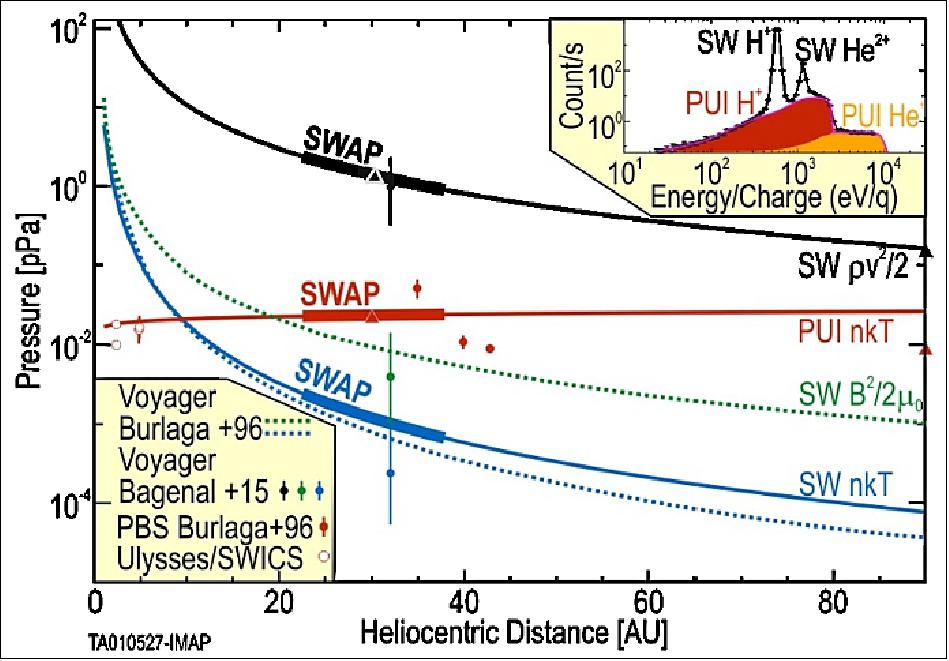
Spacecraft
IMAP operates in an L1 10º x 5º Lissajous orbit (similar to ACE). As on IBEX, the IMAP observatory is a rotating satellite with a size of 2 m in diameter and 0.7 m tall. All of the science instruments will run continuously as it rotates in space 4 rpm with the spin axis biased on average several degrees to the right of the Sun, along the nominal incoming aberrated solar wind direction. This IMAP orbit, spin-rate, and pointing approach provide ideal conditions to perform both the required in situ and heliospheric interaction measurements. The primary in situ instruments (MAG,SWE, SWAPI, CoDICE, and HIT) measure the solar wind ions, PUIs, and EPs, continuously making measurements within the required two correlation lengths (~300,000 km) from the Earth-Sun line throughout the orbit.
Heliospheric interaction instruments (IMAP-Lo, IMAP-Hi, IMAP-Ultra, IDEX, and GLOWS) also benefit from continuously operating at L1 and outside Earth's magnetosphere,significantly reducing measurement noise and foreground. ENA instruments (IMAP-Lo, -Hi,and -Ultra) are mounted to the observatory radially about the spin plane with complementing FOVs that are pointed at different angles away from the spin axis. These instruments as well as IDEX are shaded by the spacecraft. As the observatory completes a revolution,the ENA instruments measure a complete ring of the sky the width of their FOV. As the observatory repoints ~1º/day, the measurement rings fill the sky and complete a global map each six months, as on the IBEX (Interstellar Boundary Explorer) mission.
Because IMAP-Hi and IMAP-Ultra have two sensors mounted at different angles, they cover more of the sky per revolution. IMAP-Lo adjusts its viewing direction with a pivot platform. The pivoting FOV allows us to simultaneously optimize IMAP-Lo for global heliospheric imaging and tracking the flow of ISN (Interstellar Neutral) atoms. For IMAP-Lo, we plan to focus the first year on ENA viewing of the tail region (10 eV–1 keV),first global low-energy ENA maps (0.1–1 keV), and the ISN He and O peak. In the second year, we plan to focus on the possible fine structure in ENAs (0.1–1 keV) for portions of the Ribbon, and by following the flux peak of ISN D and Ne, provide the first accurate determinations of the D/H and Ne/O ratios.
Periodic, in-space cross-calibrations occur between IMAP-Lo, -Hi, and -Ultra using the overlapping energy ranges and sky coverage. Additional IMAP-Lo and IMAP-Hi in-flight cross-calibration is done with IBEX-Lo and IBEX-Hi during the 6 months after first data collection and continuously thereafter for as long as IBEX lasts. CoDICE-Lo and SWAPI and CoDICE-Hi and HIT are cross-calibrated routinely in flight. GLOWS is calibrated inflight by measuring EUV bright stars (standard candles). The baseline science phase of two years is sufficient to produce four six-month, full-sky maps from 100 eV to 300 keV.
Product | MAP Source | ACE Real-Time Cadence | IMAPI-ALiRT Cadence |
Mag Field | MAG | 60 s | 3 s |
SW Thermal Plasma | SWAPI | 64 s | 15 s |
Suprathermal Ions | CoDICE-Hi | 5 min | 1 min |
Relativistic Protons | HIT | 5 min | 1 min |
Spacecraft resources are provided to enable an extended mission to at least five years and likely much longer.
IMAP has two 4-hr telemetry contacts per week, which satisfies the NAV requirements and meets commanding needs as well as downlinking all science and housekeeping data. IMAP also continuously broadcasts a small subset of the science data for I-ALiRT (500 bit/s) to supporting ground stations around the world when not in contact with the DSN (Deep Space Network). These stations transmit the data to the IMAP SOC (Science Operations Center) to process and disseminate to the space weather community.
The IMAP SOC at LASP is responsible for all aspects of instrument operations: planning, commanding, health and status monitoring, anomaly response, and sustaining engineering for the instruments. The SOC also handles science data processing (including data calibration, validation and preliminary analysis), distribution, archiving, and maintaining the IMAP data management plan. Science data are produced centrally using algorithms,software, and calibration data provided and managed by each instrument team. The SOC maintains a version-controlled but flexible, shareable software library, and higher-level science data products are produced in machine-independent self-describing formats (CDFs,FITS).
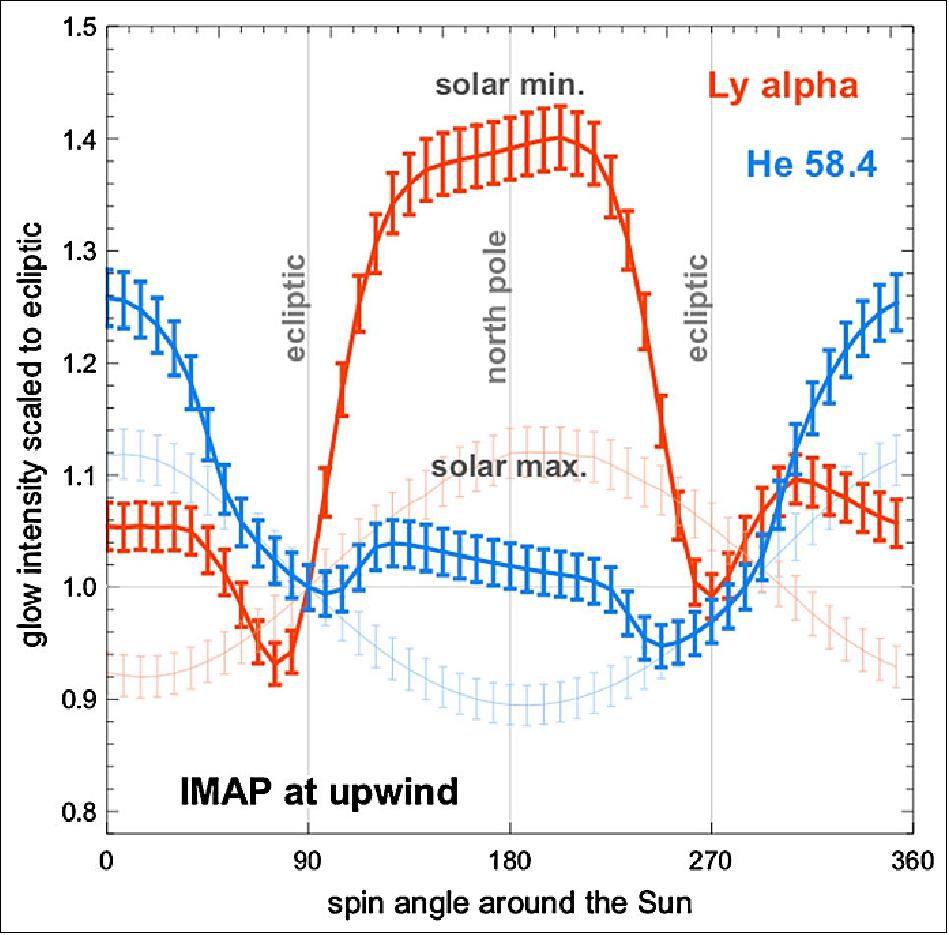
Figure 5: Representative example of simulated measurements of the Lyman-α and He 58.4 nm backscatter glows, for IMAP sitting precisely at the upwind longitude. The intensities of the Ly-α(red) and He 58.4(blue) glows, scaled to their respective values in the ecliptic plane, are shown for solar minimum (bold colors)and solar maximum conditions (pale colors). Error bars represent the expected magnitude of statistical scatter and background. The main source of the scatter for LαD are dim unresolved stars, for HeD the statistical scatter and penetrating radiation. Scanning of the glows in spin angle, with the spin axis pointing to the Sun,is equivalent to scanning them in heliolatitude. The signal modulation is due to (1) the small inclination of the ISN gas inflow direction to ecliptic (as seen for the solar maximum conditions, when solar wind is nearly spherically symmetric) and (2) due to the latitudinal structure of solar wind flux (Ly-α) and the solar wind electron density and temperature (He 58.4), expected during solar minimum conditions. For observations from downwind, the plot will be mirror-reversed in spin angle. Measuring the latitude of the ISN gas inflow is best done using the He 58.4 glow from the crosswind position (not shown); the latitude is obtained from the spin angle of the maximum signal, which corresponds to the axis of the ISN He cone (image credit: IMAP Team)
The NASA SPDF (Space Physics Data Facility) is the final archive for IMAP, with the SOC being responsible for archiving, and levels of data products are transferred to the SPDF regularly and made available through their Coordinated Data Analysis Web (CDAWeb) site with final versions archived at mission closeout. IDEX data are also archived in the PDS (PlanetaryData System). The IMAP team shares all science and other data with the heliophysics community as rapidly as practical with an open data policy compliant with the NASA Heliophysics Science Data Management Policy.
Real-Time Space Weather
IMAP enhances critical real-time space weather data through its I-ALiRT (IMAP Active Link for Real-Time) function. Data include all of the important parameters currently provided by ACE, but at significantly higher cadence (Table 1), and also include several new key parameters. Continuation of the standard ACE data helps boost understanding of the science of space weather and makes progress in the understanding of the heliophysics system more quantifiable over time through forecasting metrics. Especially with the transition in2016 of the Geospace Model from the University of Michigan's Space Weather Modeling Framework to NOAA, real-time data from L1 now drive operational, real-time space weather models directly. Even one bad solar wind density or velocity data point can result in errors,so IMAP's higher-cadence data will be useful for identifying and eliminating outliers and improving overall reliability of the predictions as well as providing more precise timing.
Equally important as extending the ACE real-time solar wind observations, is the testing of new space weather forecasting techniques driven by previously unavailable real-time data. Table 2 shows new space weather data from IMAP that may greatly enhance real-time forecasting. Enhanced electron fluxes associated with large solar events typically arrive well before the damaging protons and ions. Therefore, increases in electron flux can be used to predict the arrival time and intensity of solar energetic ions. The solar wind C6+/C5+,O7+/O6+, Mg/O, Fe/O, and Fe charge-state ratios can also be used by forecasters for situational awareness. Together with other data, they allow identification of what types of solar wind are arriving at Earth: fast versus slow solar wind, ICME (Interplanetary Coronal Mass Ejection), CIR (Corotating Interaction Region), or solar wind plasma sheet.
Product | Description | Source | Cadence |
High-Energy Electron Fluxes | ~0.5–1.0 MeV, sunward and anti-sunward | HIT | 1 min |
SW Charge-State Ratios | C6+/C5+,O7+/O6+,Mg/O,Fe/OFe(high Q)/Fe(low Q) | CoDICE-Lo | 4 min |
I-ALiRT follows the ACE, STEREO, and DSCOVR approach to provide continuous real-time products. Between DSN tracks, the flight system sends this low-rate stream to the SOC via a network of antenna partners located around the globe. During DSN tracks, the flight system includes the space weather data in the full-rate science data stream, which the MOC (Mission Operations Center) receives from the DSN and forwards to the SOC. In either case, the SOC processes this low-rate measurement data to create the space weather data products and posts them for users to retrieve. To provide data to forecasters in time for users to take protective action, I-ALiRT provides an end-to-end latency of no more than five minutes from the time of last measurement until the corresponding data product is available in the operational database.
Launch
A launch of the IMAP mission is planned for 2025 on a Falcon 9 Full Thrust rocket from Launch Complex 40 at Cape Canaveral Air Force Station in Florida (Ref. 12).
Orbit: The spacecraft will be positioned at L1 (Lagrange Point-1), 1.5 million km away from Earth towards the Sun. This will allow the probe to maximize use of its instruments to monitor the interactions between solar wind and the interstellar medium in the outer solar system.
Sensor Complement
IMAP provides an integrated and coordinated suite of 10 instruments to create the in situ and remote imaging observations of the investigation. For each, we chose high-heritage instrumentation and made judicious enhancements only where needed to achieve measurement requirements. For the critical heliospheric ENA (Energetic Neutral Atom) imaging and ISN (Interstellar Neutral) atom measurements, our IMAP team also led the IBEX-Lo, IBEX-Hi, and Cassini/INCA instruments; these three instruments effectively define the current state of the art for the required observations of neutrals from 10 eV to 70 keV. Direct cross-calibration of IMAP with IBEX, if it is still returning data in 2024, will enable creation of the IBEX-to-IMAP dataset to continue the baseline of time variations in heliospheric ENAs and extend more than 15 years of global ENA imaging (Ref. 3).
IMAP-Lo | 10–1000 eV ISN/ENA fluxes & composition |
IMAP-Hi | 0.4–15.6 keV ENA fluxes & composition |
IMAP-Ultra | 3–300 keV ENA fluxes & composition |
MAG (Magnetometer) | 2 Hz (128 Hz intervals) w/ 10 pT resolution |
SWE (Solar Wind Electron) | 1–5000 eV electron distribution at 15 s resolution |
SWAPI (Solar Wind and Pick-up Ion) | 0.1–20 keV/q solar wind ions & PUIs at 15 s resolution |
CoDICE-Lo (Compact Dual Ion Composition Experiment-Lo) | Solar Wind/PUI/ST ions 3–60 amu, <0.5 — 80 keV/q |
CoDICE-Hi (Compact Dual Ion Composition Experiment-Hi) | ST/EP ions 1 to >60 amu, 0.03–5 MeV/nuc & 20–600 keV electrons |
HIT (High-energy Ion Telescope) | EP dE/dX vs. E H-Fe ions 2–40 MeV/nuc & electrons |
IDEX (Interstellar Dust Experiment) | Dust composition 1–500 amu, m/Δm>200 |
GLOWS (GLObal solar Wind Structure) | H (Ly-α) & He (584 Å) glow—global solar wind, ionization, radiation pressure |
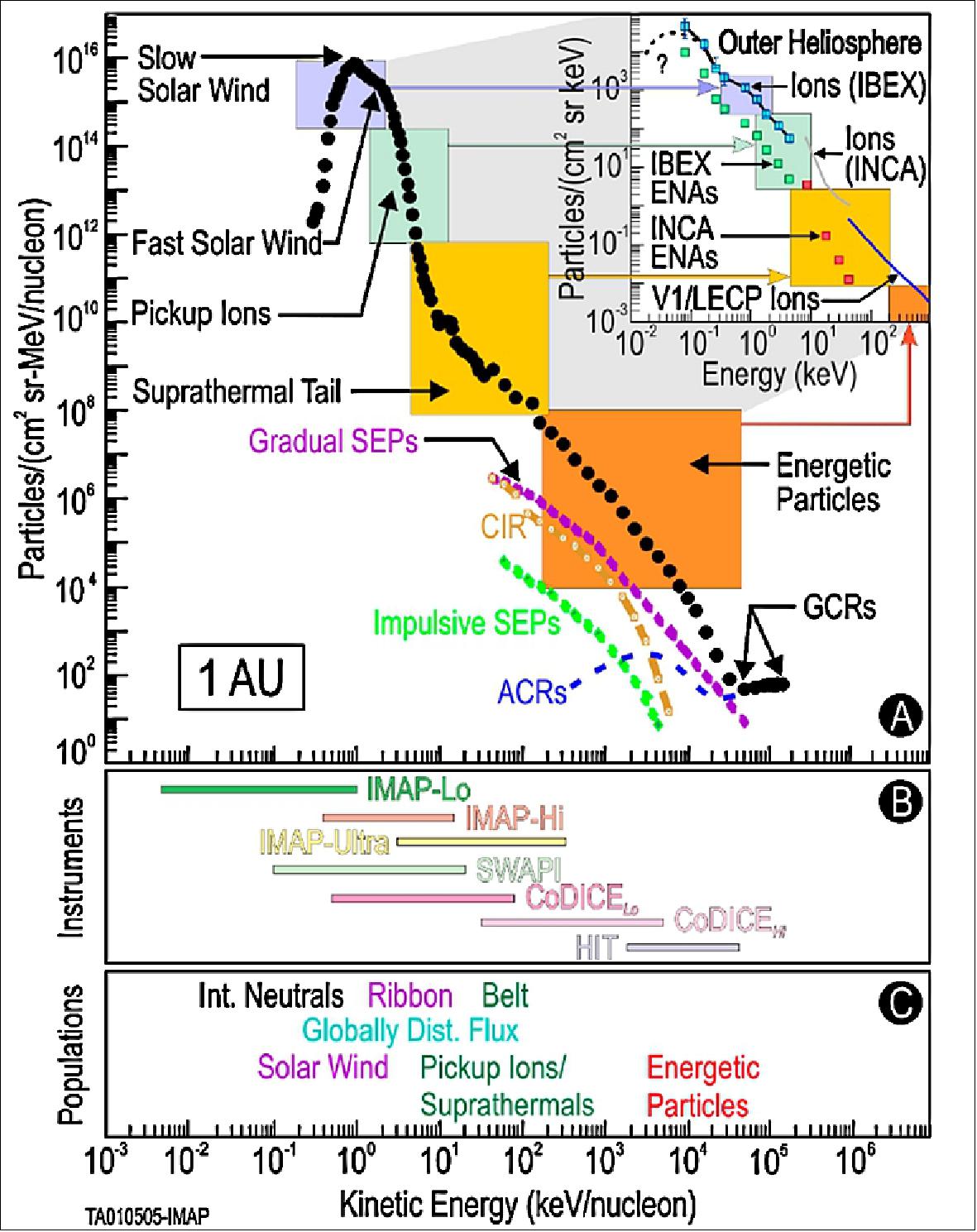
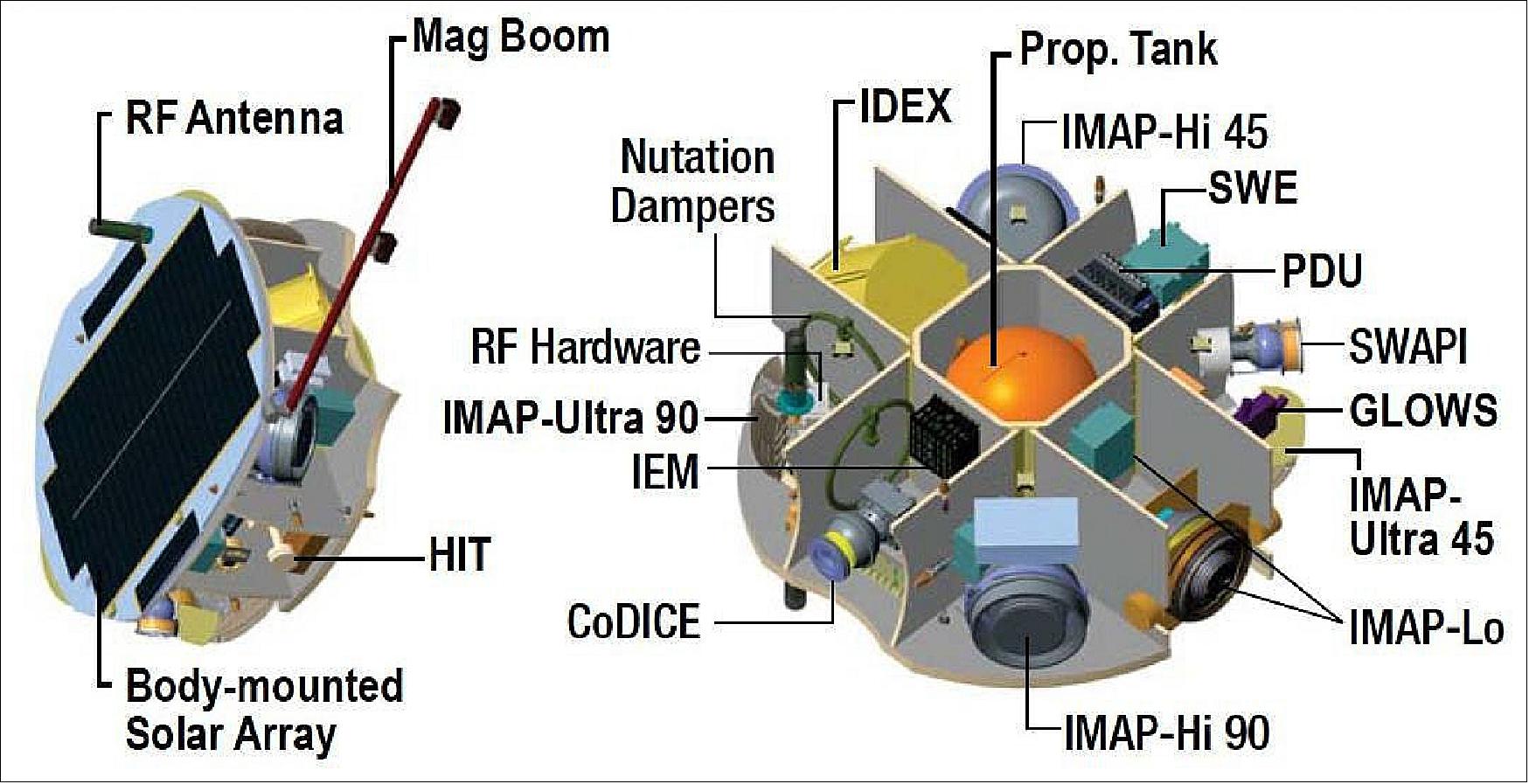
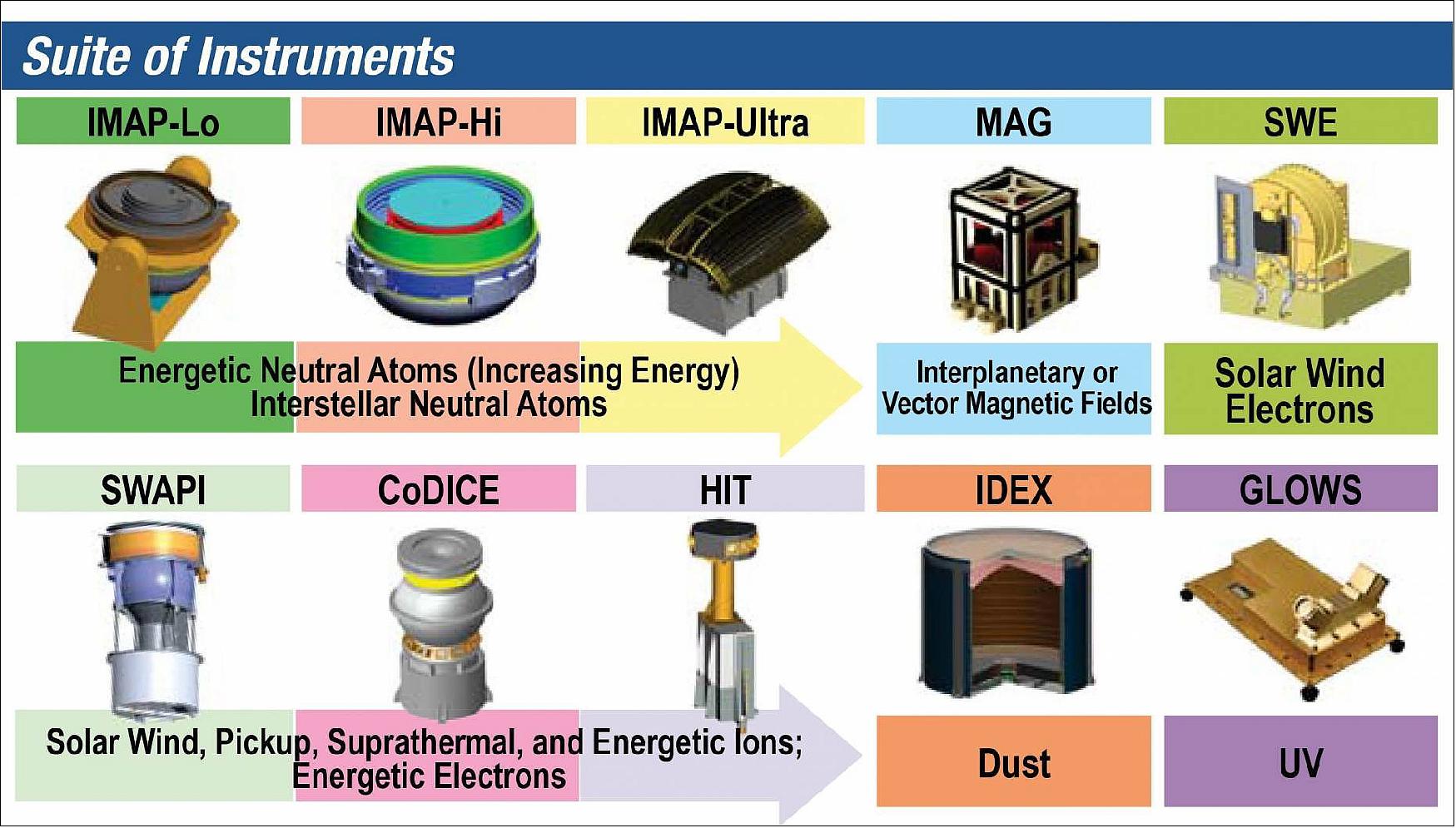
IMAP-Lo
IMAP-Lo is a single-pixel neutral atom imager mounted on a pivot platform. It delivers (1) energy and angle-resolved measurements of ISN (Interstellar Neutral) atoms (H, He, O, Ne, and D) tracked over >180º in ecliptic longitude and (2) energy resolved global maps of ENA H and O. IMAP-Lo tracks the interstellar flow to precisely determine the species-dependent flow speed, temperature, and direction of the Local Interstellar Medium (LISM) that surrounds, interacts with, and determines the outer boundaries of the global heliosphere. It returns detailed abundance information defining composition of the LISM. The ecliptic longitude, arrival direction relative to the Sun, and hyperbolic trajectory of the ISN bulk flow determine a characteristic relation between inflow longitude and speed at infinity. IMAP-Lo uses the pivoting FOV (pivot angle, PA, with FOV = 90º + PA to spin-axis) to pinpoint the intersection in the relation between the ISN inflow speed and longitude to uniquely determine the LISM flow vector. 5)
Building on heritage from the IBEX-Lo instrument aboard IBEX, IMAP-Lo provides much larger collection power due to its position at L1 (average increased viewing time 4 x due to low backgrounds) and increases in geometric factor (3.2 x), duty cycle, and efficiency of IBEX-Lo. This maximizes the weak heliospheric neutral signal, while eliminating ion, electron, and UV background sources. Combined with the pivoting FOV, IMAP-Lo improves the angular resolution of ISN flow parameters and can track the ISN flow over almost the entire year, overcoming the serious limitations facing body-fixed sensors.
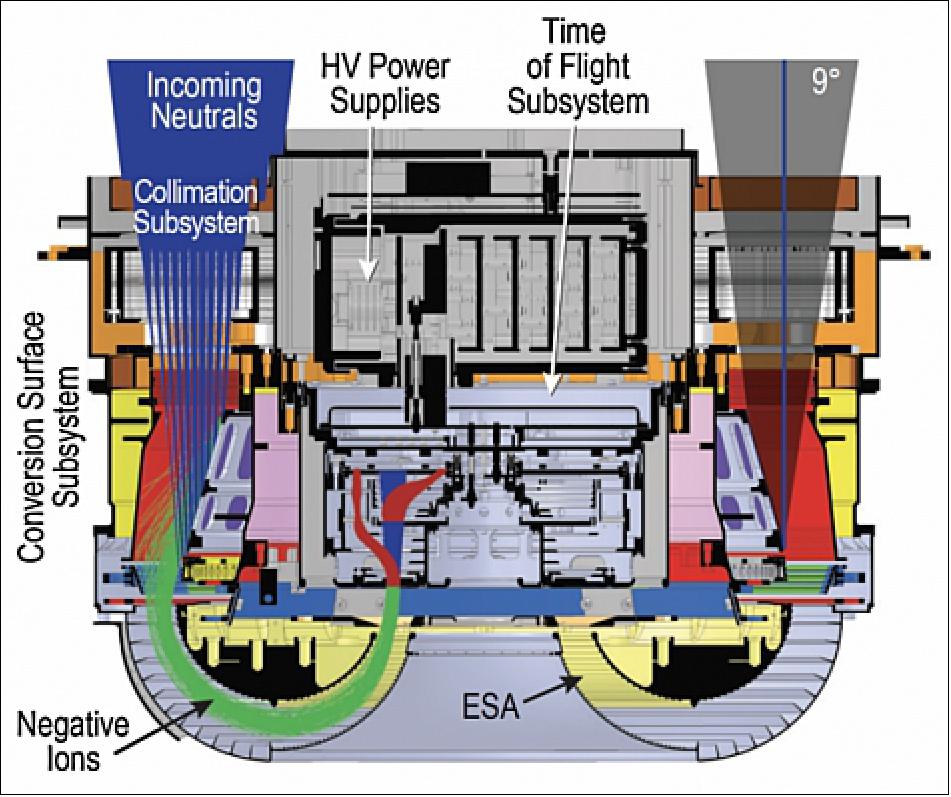
Parameter | Performance |
Instrument type | Single-Pixel ENA Imager |
FOV | 9º x 9º, pivoted FOV 60º-180º to spin axis |
Energy range | 5-1000 eV |
Pointing knowledge | 0.1º |
GE (cm2 sr eV/eV) | 1.9 x 10-4 He; 2.2 x 10-4 O; 7.8 x 10-5 H at 100 eV |
Angular resolution | 9º FWHM (Full Width Half Maximum) |
Dynamic range | 10-4 s-1 to 80 s-1 (for Triple TOF Counts) |
Time resolution | Maps: 6 months, features in ENA maps 3 months; ISN Flows: 1 year |
SNR | ISN He>10,000, ISN H>1000, ISN O>100, ISN Ne, D>10, ISN Secondary He>100, Secondary O>10, ENA H (per pixel)>10, Expected average ENA H S/N>50 |
Absolute pointing knowledge of IMAP-Lo to ≤0.1º accuracy is achieved by a co-locatedstar sensor identical in design to that on IBEX-Lo but using a photomultiplier (PMT) with a cathode less sensitive in IR to reduce sensitivity to Milky Way and Zodiacal Light background. The pivot platform orients the IMAP-Loboresight up to 180° from the spin axis, which is more than adequate to follow the interstellarflow through more than 180 days of the year.
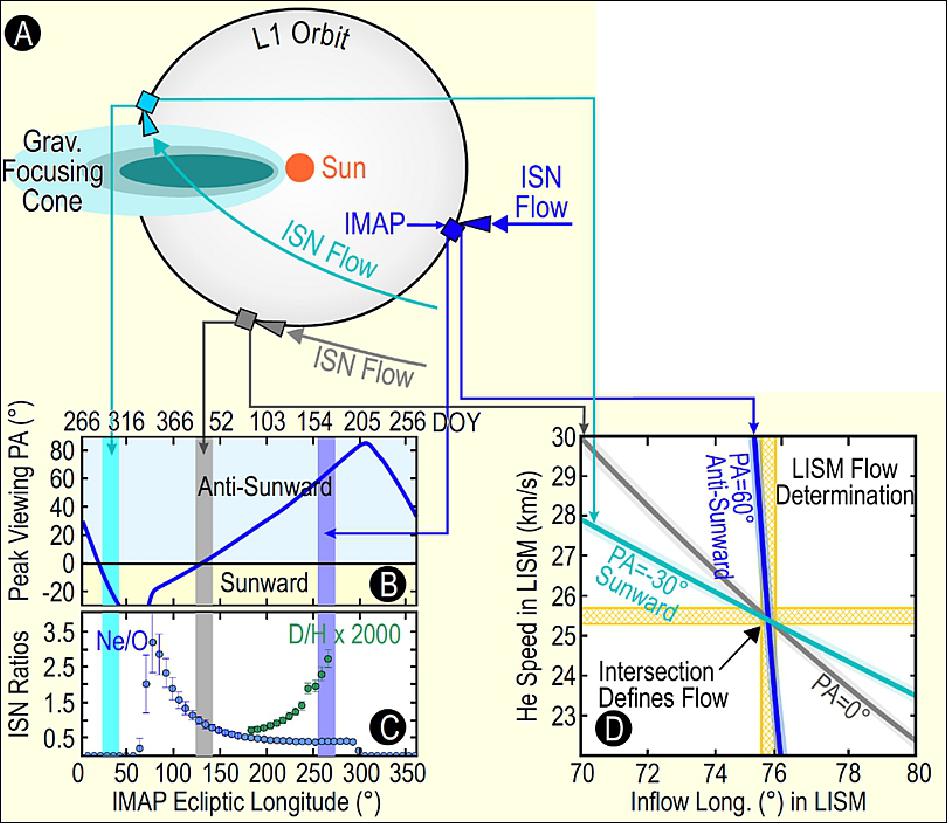
IMAP-Hi
IMAP-Hi consists of two identical, single-pixel high energy ENA Imagers that measure H, He, and heavier ENAs from the outer heliosphere. Each IMAP-Hi Imager is very similar in design to the IBEX-Hi ENA Imager aboard the IBEX mission, but incorporates key modifications that enable substantially improved (1) spectral, spatial, and temporal resolution, (2) spectral range, and (3) collection power. The instrument also incorporates time-of-flight (TOF) for identification of ENA species. These performance enhancements, yielding ~25 times the collection power of IBEX-Hi, enable unprecedented, detailed studies of structure and evolution of source plasmas in the heliosphere-LISM interaction region.6)
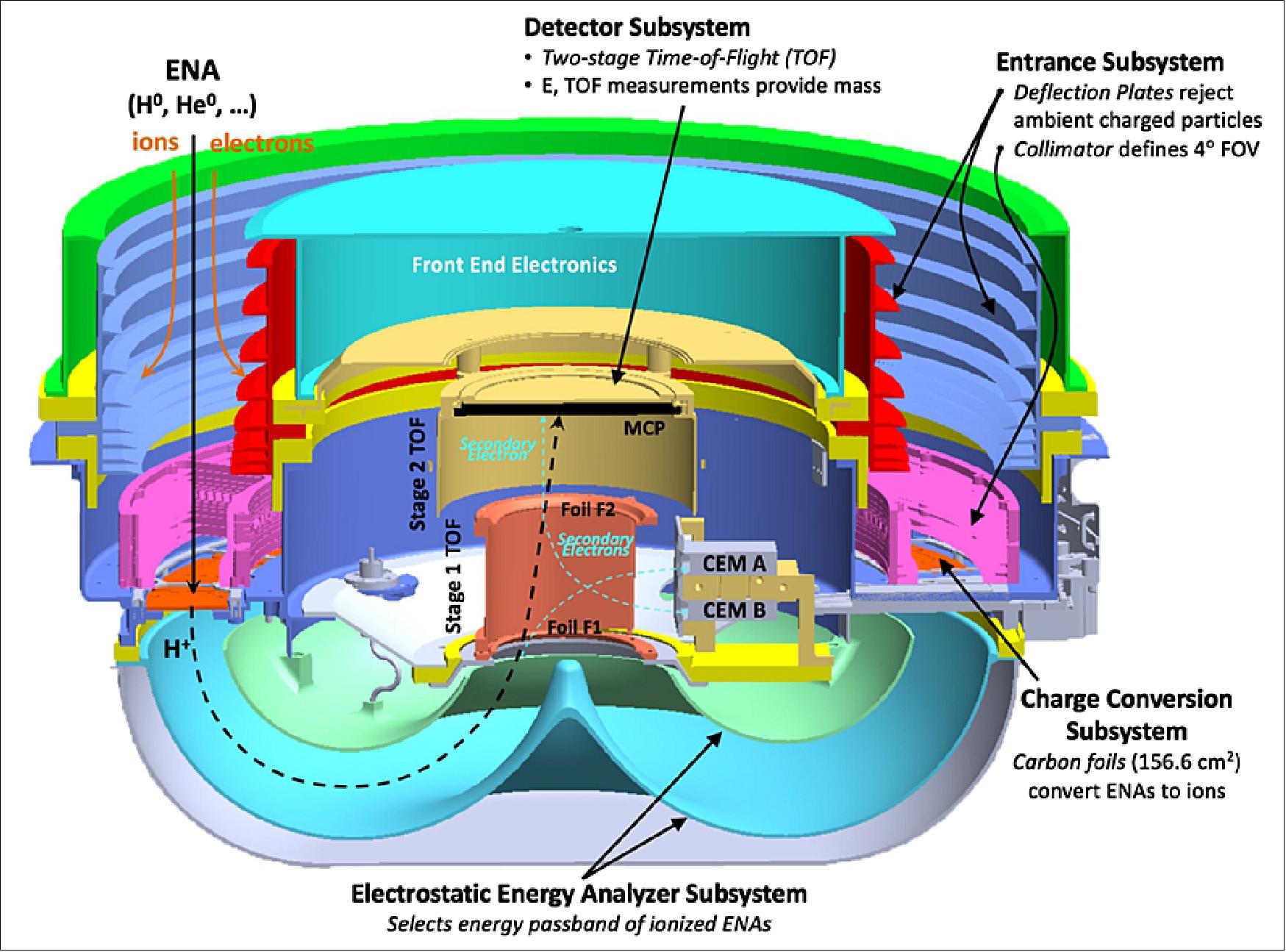
The two IMAP-Hi imagers are mounted 90° (Hi90 imager) and 45° (Hi45 imager) antisunward relative to the spacecraft spin axis, respectively. Each spin, the Hi90 imager views the ecliptic poles, while the combined Hi90 and Hi45 imagers sample the ecliptic plane in four different locations. The Hi90 and Hi45 imagers also enable viewing the same low-latitude regions twice within 3 months to probe rapid ENA time variability. Additionally, the Hi45 imager has increased exposure of a factor of x 3.9 at the equator and nearly x 10 at 45° latitude, a band that contains ENA emission from the heliospheric nose and tail, as well as most of the Ribbon and Belt.
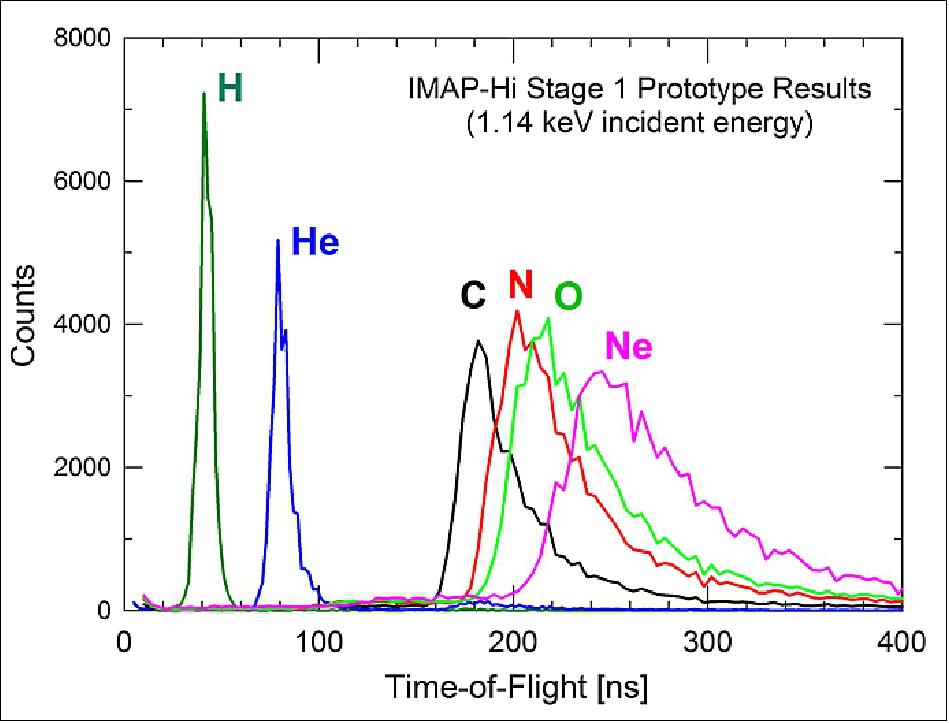
IMAP-Ultra
The IMAP-Ultra instrument (Ultra) images the emission of Energetic Neutral Atoms (ENAs) produced in the heliosheath and beyond, primarily in H atoms between ~3 and 300 keV, but also sensitive to contributions from He and O. Ultra is nearly identical to the Jupiter Energetic Neutral Imager (JENI), in development for flight on the European Space Agency's JUICE mission to Jupiter and Ganymede. Ultra's primary differences from JENI include: (1) the use of 2 identical copies, one mounted perpendicular to the IMAP spin axis (Ultra90) and one mounted at 45º from the anti-sunward spin axis (Ultra45) for better sky coverage and more uniform sensitivity over the heliosphere, similar to IMAP-Hi, and (2) the use of slightly thicker, UV-filtering foils covering the back plane MCPs to reduce backgrounds associated with interstellar Lyman-α photons. High resolution images covering over 50% of the heliosphere are produced every ~3 months, contributing to the understanding of the particle spectra and pressures in and beyond the heliosheath, and detecting changes in the spatial distribution of those particles on time scales sufficient to track both solar cycle as well as major active region dependencies. 7)
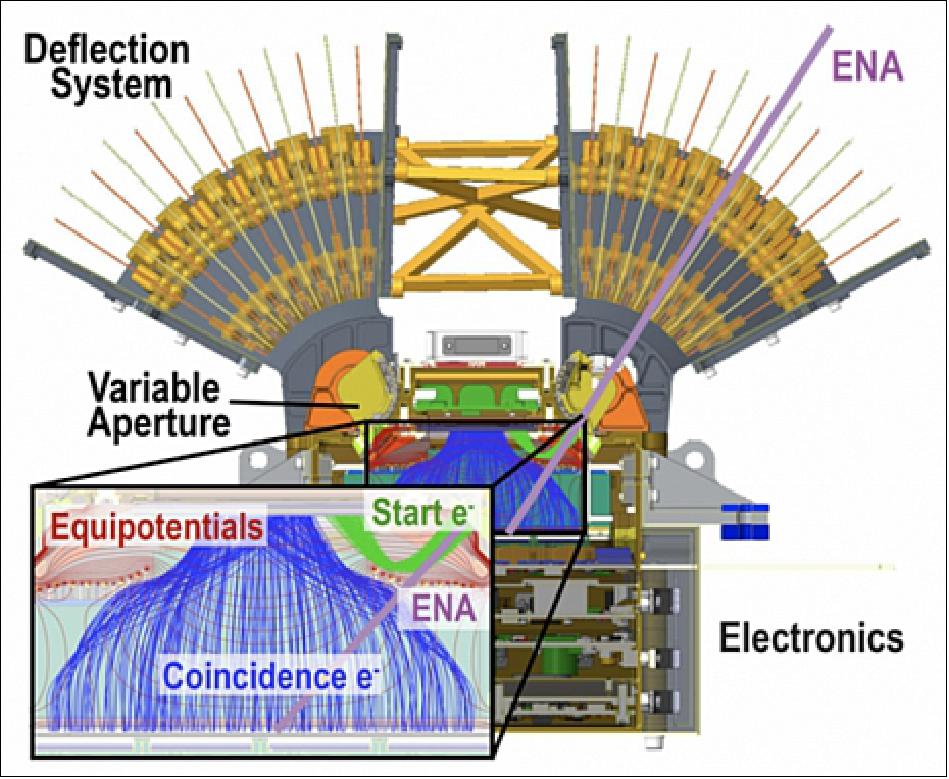
Ultra will complement the measurements of IMAP-Lo and IMAP-Hi, providing overlap in energy with IMAP-Hi for heliospheric energetic H, with comparable or better angular resolution, and extending the measurements through the range covered previously by Cassini/INCA with much improved sensitivity, angular resolution, and background rejection.
Parameter | Performance |
Instrument Type | Slit-based ENA Imager |
Species | Neutrals, ions, e- |
FOV | 90º x 120º (MCPs); 70º x 120º (SSDs) |
Angular Resolution | 2º (H>10 keV); 10º (O>30 keV) |
Energy Range | 3–300 keV (H), 5 MeV (ions) [TOF-only]; 35–x(H), 60–x(He), 0.08–x(O) [TOF x E], where x=300 keV/q neutrals, 5 MeV ions; 30–700 keV (electrons, SSD-only) |
Energy Resolution | ≤14% (>10 keV) |
GF(cm2 sr) | 0.012–0.31 (high resolution, low background) 1.22 (high sensitivity) |
SNR | Function of energy: ~10 to 1000 |
Mass Resolution | MCP-based: H (lights), O (Heavies) |
MAG (Magnetometer)
The IMAP magnetometer (MAG) consists of a pair of identical triaxial fluxgate magnetometers based on the Magnetospheric Multiscale (MMS) magnetometers, for which UCLA built 4 electronics units and 9 fluxgate sensors. On IMAP, the magnetometers are both mounted on a 1.8 m boom to reduce the impact of the magnetometer on spacecraft design, and through gradiometry to reduce the effect of spacecraft magnetic fields on the measurements of the instrument by dynamically removing the spacecraft field. This technique was tested and proven valuable on the Venus Express mission with only a 1 m boom and no magnetic cleanliness program. Even the signals of the Venus Express spinning magnetic reaction wheels were removed. The gradiometer not only maintains an accurate baseline for space weather applications, but also allows new insight into waves and turbulence in the solar wind to frequencies near the electron gyrofrequency. MAG's performance parameters are summarized in Table 6.
Parameter | Performance |
Instrument Type | Vector Triaxial Fluxgate Magnetometer |
Sample Rates | 2 Hz; 128 Hz |
Dynamic Rabge | ±500 nT |
Resolution | 10 pT |
Zero-Level Stability | <0.1 nT baseline drift per month |
Each magnetometer resembles the complete assembly with cable shown in the inset in Figure 14. Assembly is straightforward with the main frame bottom supporting the cable and triaxial sensor. The sensor's printed circuit board sits in the main frame bottom and the Zcore assembly lies on top of the board. The XY core assembly is a single core wrapped to measure two components (X and Y) of the magnetic field. The assembly is capped with the main frame top which also contains a second printed circuit board. The three orthogonal pairs of nulling coils wrap around the outside of the main frame. This sensor design has been successfully used for nearly 4 years in space at this writing on 8 instruments on the 4 MMS spacecraft.
The magnetometer uses sigma-delta digitization integrated in the measurement loop to generate values along each axis that are sent continuously to the processor board. The processor provides two output streams, one 128 Hz for scientific studies of the local magnetized plasma and one at 2 Hz to serve the real-time space weather monitoring system. The dynamic range is±500 nT that easily envelops the largest interplanetary magnetic field ever recorded and are returned to Earth as three 24 bit components. The high stability of the zero levels of these cores together with the real-time operation in the Alfvenic fluctuations in the solar wind allow the baseline zero level to be maintained to±0.1nT.
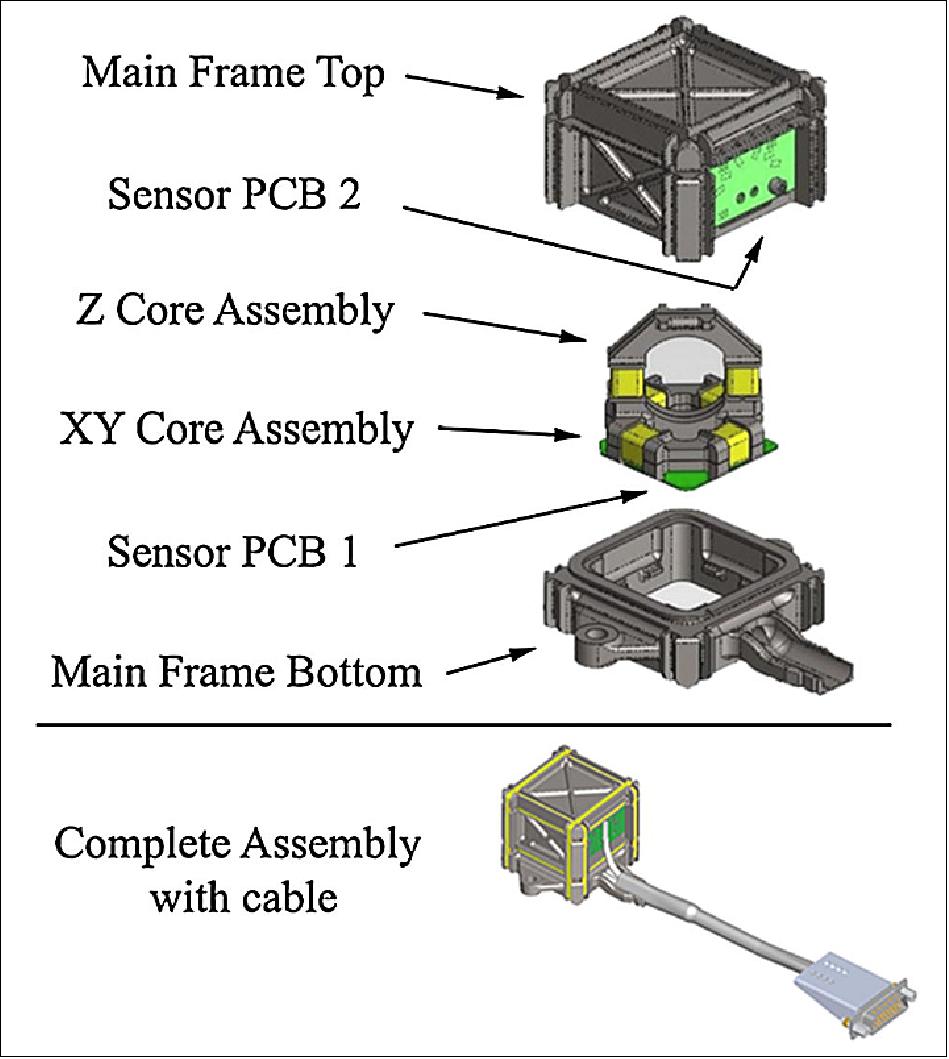
SWE (Solar Wind Electrons)
The SWE instrument will measure the 3D distribution of thermal and suprathermal electrons from 1 eV to 5 keV. SWE is optimized to detect in-situ solar wind electrons at L1 in order to understand the solar wind structures and provide context for the energetic neutral atom measurements. SWE is based on the heritage Ulysses/SWOOPS, ACE/SWEPAM and Genesis/GEM instruments, with updated electronics based on Van Allen Probes/HOPE. SWE is optimized to measure in situ solar wind electrons at L1 to provide context for the ENA measurements and perform the in situ solar wind observations necessary to understand the local structures that can affect acceleration and transport.
Parameter | Performance |
Instrument Type | SW Electron ESA (Electrostatic Analyzer) |
FOV | 160º x 12º instantaneous |
Angular Range & Resolution | Polar angle range 10–170º, 21º resolution |
Enery Range | 0.001–5 keV |
Energy Resolution | 12% |
GE(cm2 sr eV/eV) | 2–7 x 10-4 per pixel |
Dynamic Range | Up to 500 kHz |
Time Resolution | 15 s |
SWE consists of a spherical section ESA followed by seven CEM (Channel Electron Multiplier) detectors (Figure 15). Electrons enter through an aperture pointed normal to the space-craft spin axis. A positive HV on the inner ESA plate biases the analyzer such that only electrons within a narrow range of energies and azimuthal angles pass through and are detected by the CEMs. Stepping this voltage provides coverage of the full energy range. Electrons entering the instrument at different angles relative to the aperture normal are detected in different CEMs, yielding 21° polar angle resolution within the fan-shaped FOV. As the IMAP spacecraft spins, the SWE fan-shaped FOV sweeps out>95% of 4π sr, missing only small conical holes centered parallel and antiparallel to the spin axis. The curved-plate ESA is composed of nested 120° spherical grooved and blackened Al alloy plates. The plates have a gap width of 3.5 mm and an average radius of 41.9 mm.
SWE measurements are made by each of the seven CEM detectors as a function of spin angle and energy step. The~12% energy resolution and ~12º x 21º angular resolution allow full characterization of the solar wind electron distributions, including moments and energy and angle distributions of the thermal, suprathermal, and strahl populations. The extension of the energy range to 5 keV also permits characterization of the superhalo population. SWE, together with SWAPI and MAG, also provide 1 AU context for IMAP ENAobservations, including measurement of solar wind structures and dynamics.
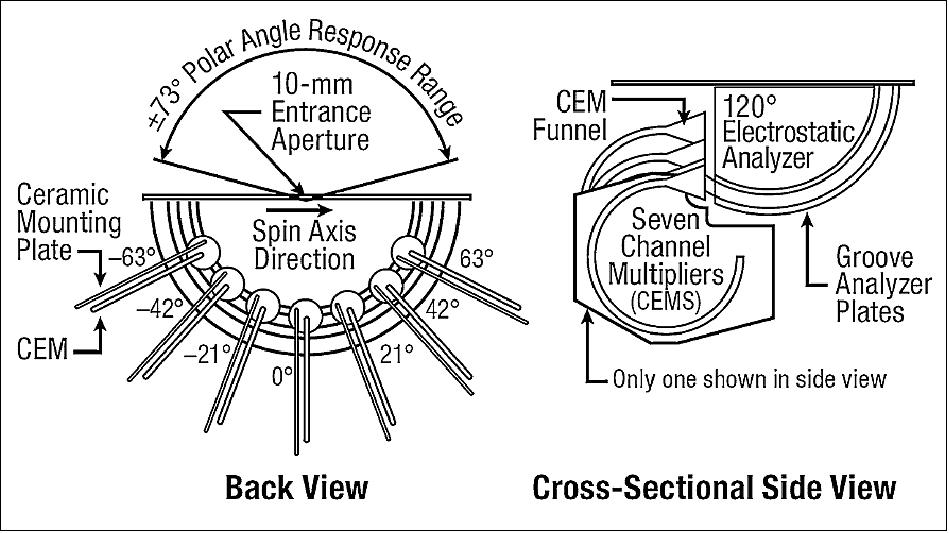
SWAPI (Solar Wind and Pickup Ion)
The SWAPI instrument measures solar wind H+ and He++ and interstellar He+ and H+PUIs (Pickup Ions). SWAPI is nearly identical to the NH Solar Wind Around Pluto (SWAP) instrument, which has over a decade of flight-proven observations of solar wind and PUI distributions . SWAPI is a simplification of SWAP, and by removal of SWAP's retarding potential analyzer, significantly increases transmission and improves sensitivity, further enhancing PUI observations.
Detailed measurements of these populations are fundamental to understanding the solar wind context, sources and acceleration of particles, PUIs, and the physical processes regulating the global heliosphere. SWAPI delivers the high time and energy resolution required to identify local acceleration processes. SWAPI's instrument performance parameters are summarized in Table 8.
Parameter | Performance |
Instrument Type | SW/PUI Spectrometer ESA |
Species | SW H+ and He++; Interstellar He+ and H+ |
FOV | Sun-viewing: 20º x 10º; Non-Sun-viewing: 256º x 10º |
SNR | Min. SNR of 1 @ 0.07 Hz coincident count rate |
Energy Range | 0.1–20 keV/q |
Energy Resolution | 8.5% |
GE (cm2 sr eV/eV) | SW Sun-viewing: 1.1 x 10-7 for SW protons |
Dynamic Range | 2 MHz to 0.07 Hz counting rates |
Time Resolution | 15 s |
The SWAPI electrooptics (Figure 16) consists of a grounded aperture grid that attenuates the solar wind beam without reducing PUIs from all other directions, an ESA for energy-per-charge (E/q) selection, a field-free flight path, and a coincidence detector section. These elements select the energies and separate geometric factors for solar wind and PUIs. Transmitted ions are post-accelerated into the detector section that employs an ultrathin carbon foil and two CEMs to make a coincidence measurement when both the primary particle and front-side secondary electrons are detected within a 100 ns window.
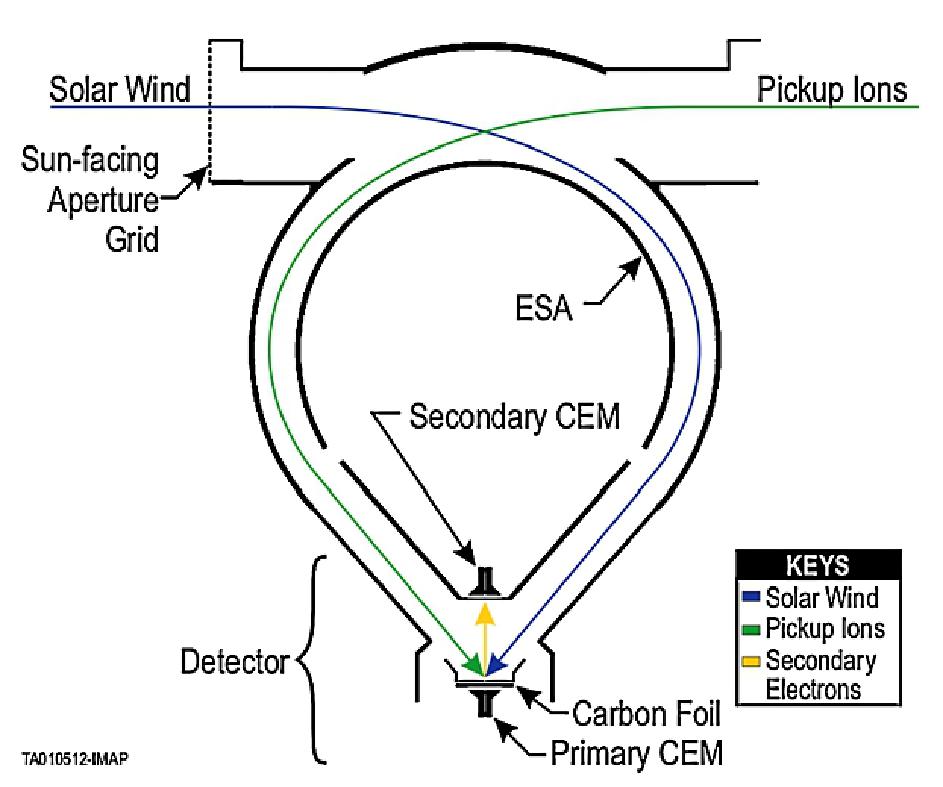
By properly masking the sunward direction, SWAPI makes critical measurements of the solar wind conditions at 1 AU, including H+,He++, and heavier ions during cold solar wind conditions such as in many interplanetary coronal mass ejections (ICMEs). Away from the solar wind direction, there is no aperture reduction, increasing PUI sensitivity by 5 x compared to SWAP. The SWAPI energy range is extended up to 20 keV/q to capture the1D He+and H+PUI distributions and cutoffs, as well as both the solar wind H+and He++ distributions. In addition to providing outstanding solar wind observations, SWAPI's rapid measurements of PUI He+enable critical new understanding of ion pickup and acceleration processes. Figure17 shows an example of a coincidence sweep of SWAP observations at ~26 AU (black) and modeled measurements at 1 AU from SWAPI (green/grey).
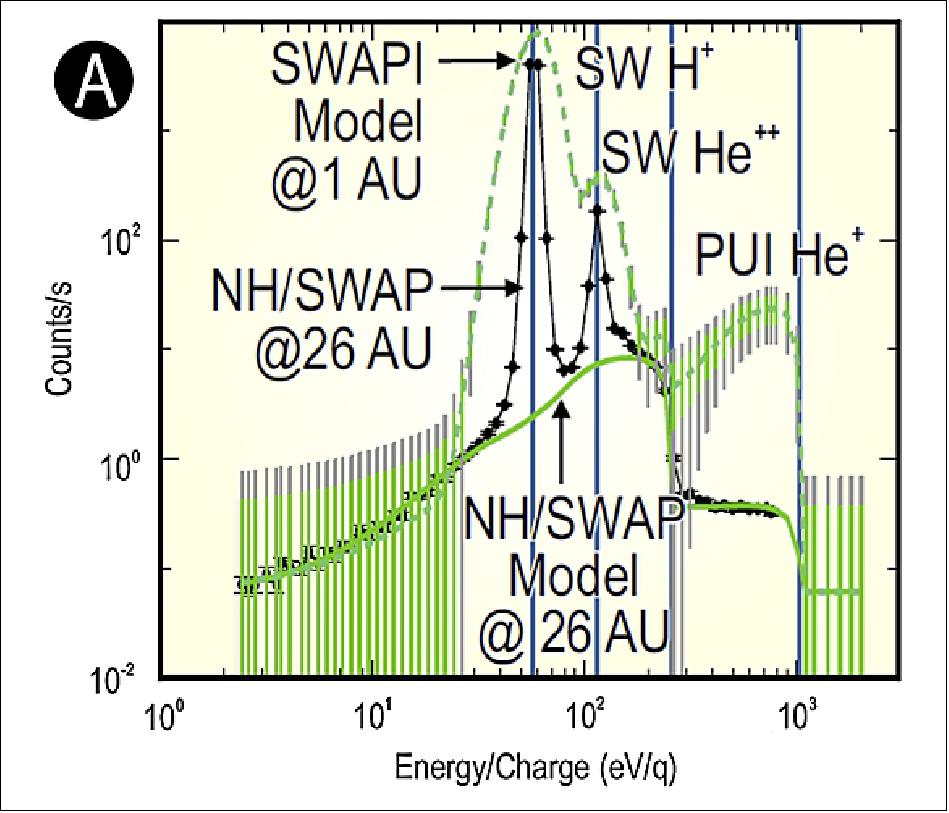
CoDICE (Compact Dual Ion Composition Experiment)
CODICE combines an ESA with acommon TOF versus energy (TOF/E) subsystem to simultaneously measure (1) the 3D VDFs (Velocity Distribution Functions) and ionic charge state and mass composition of ~0.5–80 keV/q ions in CoDICE-Lo, and (2) the mass composition and arrival direction of ~0.03–5 MeV/nuc ions in CoDICE-Hi. CoDICE-Hi also measures ~20–600 keV electrons. These measurements, summarized in Table 9, are required to (1) determine the LISM composition and flow properties and (2) discover the origin of the enigmatic suprathermal tails and advance understanding of the acceleration of particles in the heliosphere. Figure 18 shows the overall design of CoDICE.
CoDICE-Lo measures ions between ~0.5 and 80 keV/q that enter the collimated aperture (blue trajectories in Figure 18) and are selected and focused according to their E/q into the Start TOF subassembly. The E/q sweeping steps up to the maximum voltage for the next stepping cycle when solar wind H+ count rates near ~1 keV/q exceed a predefined threshold rate. The Start subassembly, biased at ~15 kV, accelerates the incoming ions before they strike a thin carbon foil (~1 µg/cm2) at the entrance of the TOF/E subsystem. This interaction produces secondary electrons (red trajectories) that are guided to the outer annulus of the Start MCP. The mostly neutralized ions (black trajectories) traverse a 9.7 cm flight path and strike one of 24 APDs (Avalanche Photodiodes) where they generate secondary electrons that are guided to the center of the Stop MCP (purple trajectories). The TOF between the Start and Stop MCP signals yields the ion velocity. The residual energy(E) of the neutralized ion is measured by one of the 24 azimuthally distributed APDs that collectively provide 6º x 360º instantaneous FOV and cover ~2.7π sr in a spacecraft spin. The combined measurements, E/q, TOF, and E, determine the mass (M), charge state (q),and M/q.
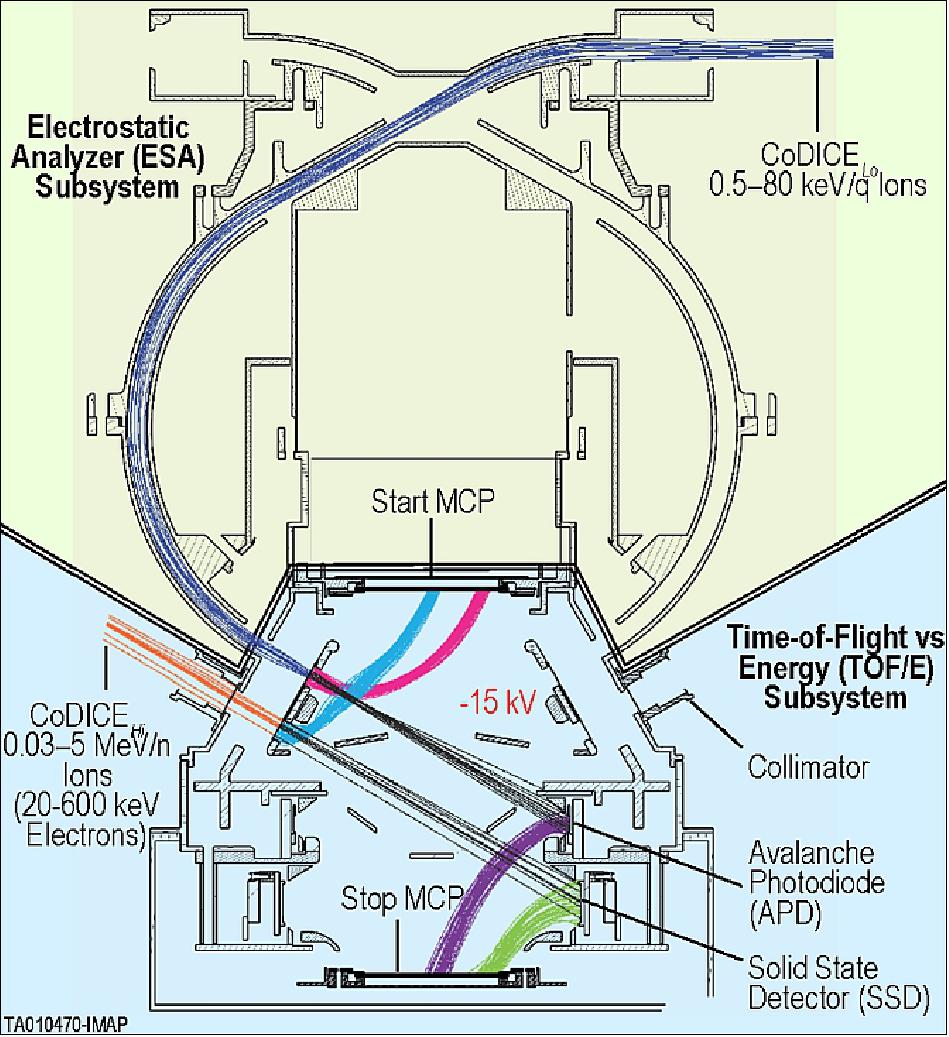
CoDICE-Hi measures ions between ~0.03 and 5 MeV/nuc (orange trajectories) that enter the common TOF/E subsystem through 12 separate 12º x 7º FOV collimators and 100 nm Al-C-Si foils that attenuate UV light to<0.1%and stop low-energy(<10 keV) protons. Start and Stop MCP signals are generated by secondary electrons (light blue and green trajectories) that are produced as the ions traverse a thin ~1 µg/cm2 C foil located at the TOF/E entrance and strike one of 12 SSDs distributed over 360° azimuth, respectively. Each SSD, 700 µm thick with an active area of 15 x 15 mm2, determines the ion's E. This, along with the TOF, yields the ion velocity and provides the ion mass. The secondary electrons are detected by the same MCPs shared with CoDICE-Lo, but in separate areas; Hi-Start electrons(light blue trajectories) are guided toward the center portion of Start MCP, and Hi-Stop electrons (green trajectories) are guided toward the outer annulus of Stop MCP. Electrons>20 keV are identified by deposited energy and<2 ns TOFs. In addition, two partially segmented SSDs at 45° to Sun-Earth line are flashed with Al to block low-energy ions. CoDICE-Hi covers 1.8π sr in each spacecraft spin.
Figure 19 summarizes the prototype test results for<300 keV ion beams, confirming the power-law relationship between TOF and E and validating CoDICE performance for species separation.
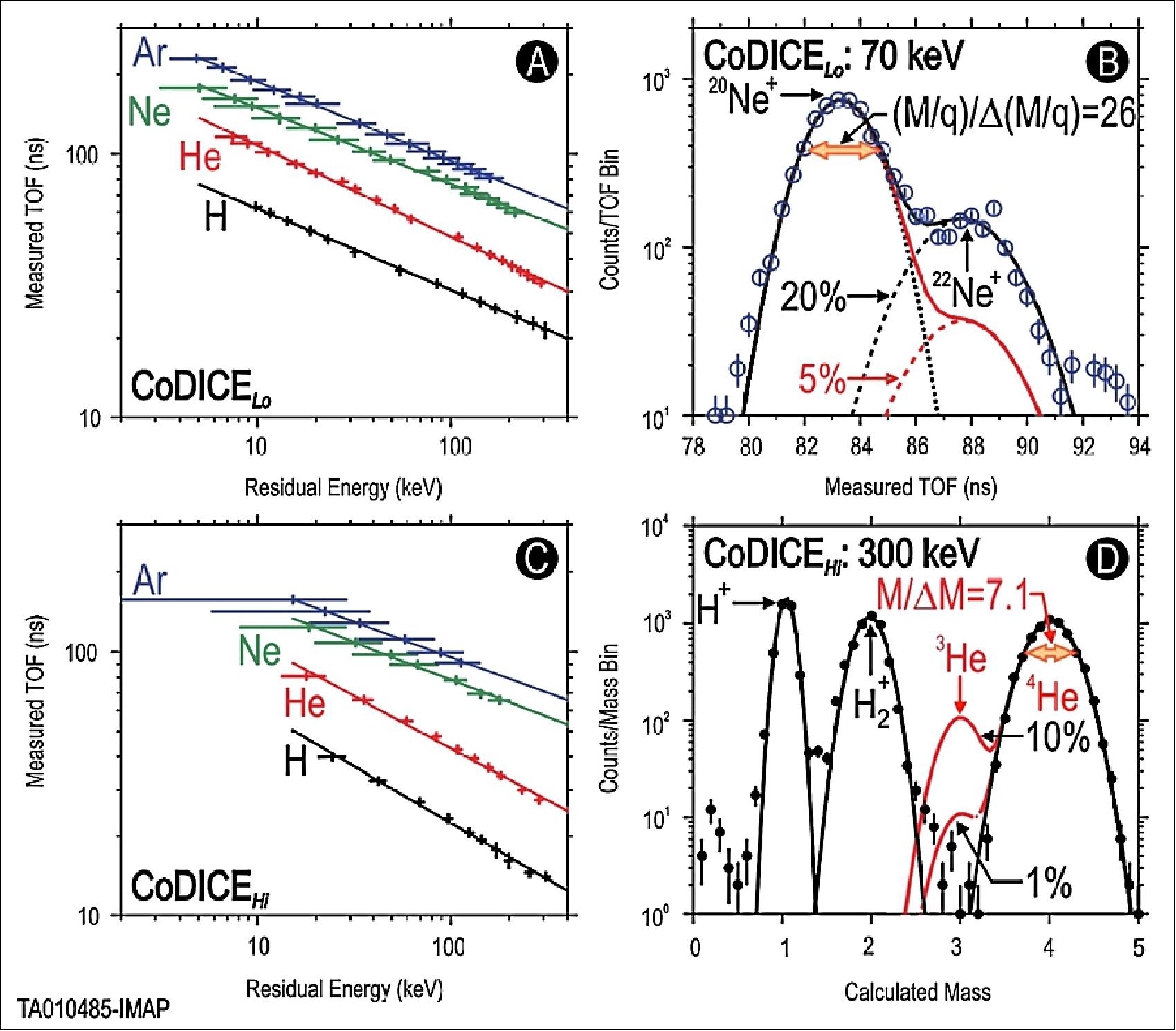
Name | Performance: CoDICE-Lo | Performance: CoDICE-Hi |
Instrument Type | PUI, SW, & ST Ion Spectrometer, ESA/TOF/E | ST & Energetic Particle Spectrometer, TOF/E |
Pointing Knowledge | <1º | <1º |
Species | Interstellar PUIs: 3He+, 4He+, N+, O+, Ne+, Ar+; Inner Source | H-ultra ions: energetic electrons |
Energy range & | <0.5-80 keV/q @ ΔE/E~0.03; Analyzer constant=5.75 | 0.03-5 MeV/nuc; |
Mass range & | M: 3-60 amu, (M/q)/Δ (Μ/q) ≤25, mass dependent | M: 1->60 amu |
Instantaneous FOV | 6º x 360º; 2.7π sr | 12 10º x 7º look directions over 360º azimuth |
Angular range & | Angular resolution azimuth x Spin plane: 15º x 5º | 1.8π sr |
Dynamic range | Quiet time — 105 c/s | Quiet time — 105 c/s |
Time resolution | 3D VDFs of He- @ 40 min; | H, He- @ 1 min; |
GE or GF | GE~1.4 x 10-3 (cm2 sr eV/eV | GF~0.2 (cm2 sr) |
Observational modes | E/q scans optimized to reduce H counts & increase duty cycle of STs | N/A |
HIT (High-energy Ion Telescope)
HIT measures the elemental composition, energy spectra,angular distributions, and arrival times of H to Ni ions over a species-dependent energy range from ~2 to ~40 MeV/nuc. HIT, heavily based on the LET ( Low Energy Telescope)on the STEREO (Solar Terrestrial Relations Observatory), delivers full-sky coverage from a large GF instrument to enable 1 min resolution of ion anisotropy measurements, observing the ramps of local shocks, anchoring the high-energy SEP ion spectra, and resolving particle transport in the heliosphere. HIT's instrument performance parameters are summarized in Table 10.
Parameter | Performance |
Instrument type | Energetic Particle Spectrometer, dE/dx vs E |
Species | H-Fe, e- |
Energy range | ~2–40 MeV/nuc, species dependent (higher energy not needed locally), |
Angular range & resolution | 30º x 30º bins, all sky (4π) |
Time resolution | 1 min |
GF & SNR | GF= 4 cm2 sr & SNR>100 |
Mass range & resolution | M/ΔM ≥ 7 (needed for 3He/4He) |
Dynamic range | Quiet time up to 105 per second |
HIT (Figure 20) is a standard dE/dx versus Etot spectrometer, where ionization losses, as a charged particle passes through multiple silicon SSDs (Solid State Detectors), are used to characterize a particle's nuclear charge, energy, and mass. The instrument consists of a sensor head and electronics box, separated by a mechanical bracket.
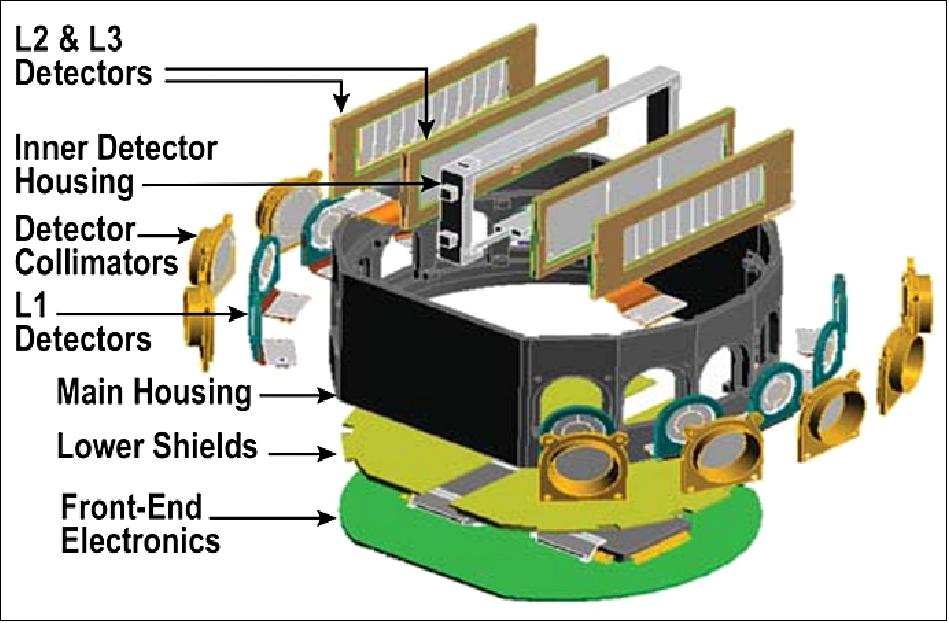
The L1 detectors have an active area of 2 cm2 split into three segments. Eight of the L1s are 24 µm thick, as on STEREO/LET. These eight apertures, oriented perpendicular to the spin axis, sweep out a 4π, full-sky coverage. Two L1s, pointed in the sunward and anti-sunward directions are 1000 µm thick, so that they are sensitive to electrons. These two apertures are used for the I-ALiRT space weather data stream, reporting electron fluxes from ~0.5–1.0 MeV, which can be used as a predictor of SEP proton intensities that arrive later in an event.
The two L2 detectors are 50 µm thick with an active area of 10.2 cm2 across 10 segments and the L3 detectors are 1000 µm thick with an active area of 15.6 cm2 in two segments. The active area segmentation enables the measurement of arrival direction, which is used for angular path-length corrections and to observe SEP anisotropies. Figure 21 shows the ion resolution obtained with the LET instrument on STEREO-Ahead, demonstrating that the HIT design will meet the IMAP requirements.
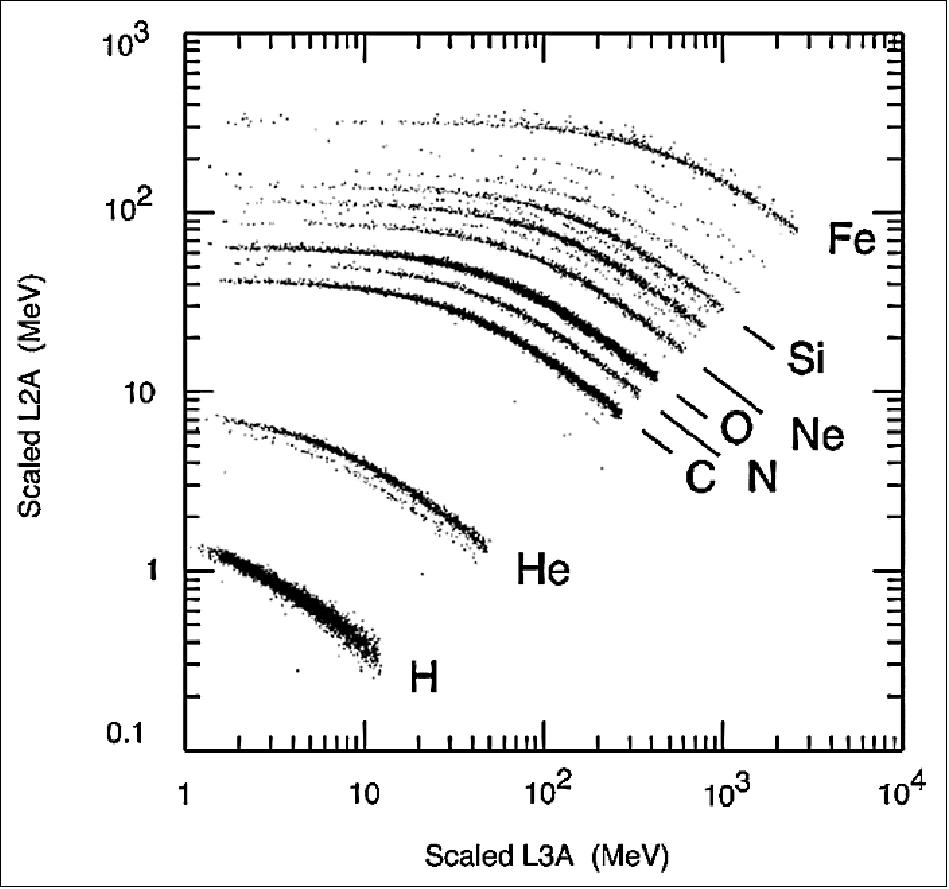
IDEX (Interstellar Dust EXperiment)
IDEX (Interstellar Dust EXperiment) is a high-resolution dust analyzer that provides the elemental composition, speed and mass distributions of ISD particles. IDEX links the interstellar gas phase composition, as obtained with IMAP-Lo and through PUIs with CoDICE and SWAPI, with the makeup of ISD (Interstellar Dust) particles. IDEX's instrument performance parameters are summarized in Table 11.
Parameter | Performance |
Instrument type | Time-of-Flight Dust Spectrometer |
FOV | ±50º |
Mass range resolution | 1–500 amu, m/Δm ≥200 |
IDEX has two components, an electronics enclosure and a sensor head with a large effective target area (700 cm2) to collect a statistically significant number of dust impacts (>100/year), based on Ulysses-derived fluxes. The IDEX low-mass mechanical design consists of a simple Al shell structure that provides support for the biased electrodes of the TOF ion mass analyzer and the grids over its aperture. The centrally-located ion detector and the front-end charge sensitive amplifier are integrated into the bottom of the instrument.
The two L2 detectors are 50 µm thick with an active area of 10.2 cm2 across 10 segments and the L3 detectors are 1000 µm thick with an active area of 15.6 cm2 in two segments. The active area segmentation enables the measurement of arrival direction, which is used for angular path-length corrections and to observe SEP anisotropies. Figure 22 shows the ion resolution obtained with the LET instrument on STEREO-Ahead, demonstrating that the HIT design will meet the IMAP requirements.
A mass spectrum is obtained for each particle measured from the TOF analysis of the impact generated atomic and molecular ions .Individual dust particles entering the instrument pass through a set of grid electrodes and impact the target (Figure 22). The target is biased at+3 kV to provide positive ion acceleration and reflectron-type ion optics are used to generate TOF compositional mass spectra. An electrostatic field, shaped by a set of biased rings and a curved grid electrode, provides spatial and temporal focusing of the accelerated ions onto the central detector. IDEX's wide mass range of 1–500 amu is designed to identify the elemental makeup of impacting particles with selected mineralogical information. Organic molecules can be identified as well,if present.
Figure 22 also shows a mass spectrum from a prototype instrument and analog mineralogical dust particles obtained at a dust accelerator. The large ISD speeds increase the impact charge, that combined with IDEX geometry, provide a higher sensitivity than previous instruments, and an accurate dust mass estimate (M/ΔM>2).
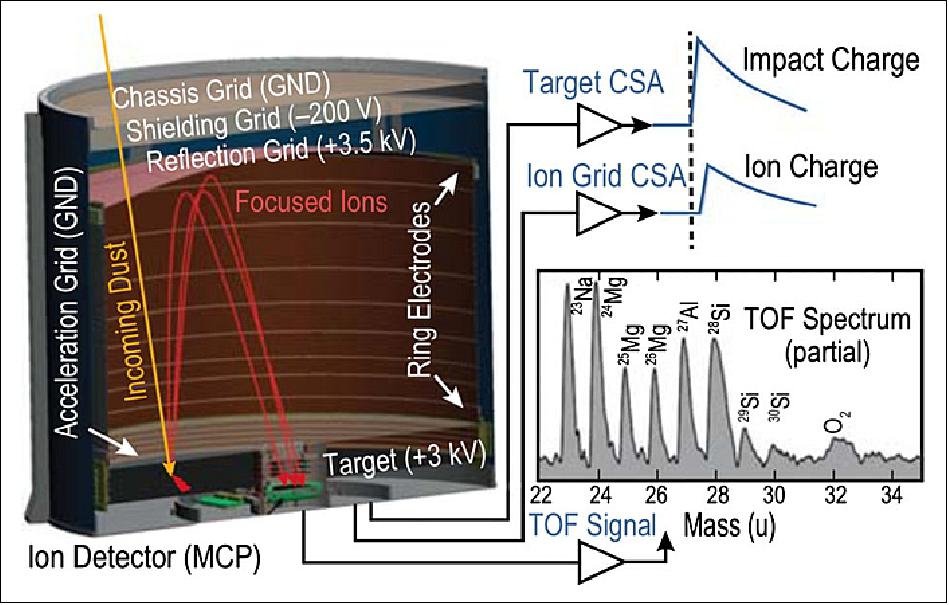
GLOWS (GLObal solar Wind Structure)
The GLOWS instrument measures the heliospheric resonant backscatter glow of hydrogen (the Lyman-α line at 121.6 nm) and helium (at 58.4 nm).GLOWS consists of two separate detectors: LαD and HeD for the two spectral channels,with the lines of sight directed at different angles with respect to the IMAP rotation axis, and a common on-board computer and power supply. The detectors are very similar in design,based on the successful LαD detector operating on the TWINS mission. The Lyman-α detector LαD is almost identical to LαD on TWINS, and HeD only has a new monochromator unit, which is a reflective grating behind a specially designed collimator baffle. The GLOWS's instrument performance parameters are summarized in Table 12 and the basic scheme of the HeD detector is presented in Figure 23.
Parameter | Performance |
Species | Hydrogen, Helium |
Wavelengths | H: 121.6 nm, He: 58.4 nm; monochromatic |
Angular Range & Resolution | Almost-full-sky map per 6 months (Ly-α);±20º x 360º; |
Time resolution | LαD: 2 hr for 4º Belt, almost great circle Sun-centered; HeD: 2 hr for 4º Belt, 40º in diameter Sun-centered |
SNR | LαD:>100 |
G-Factor | LαD: 2 counts/s/R |
Dynamic range | H: max-to-min ratio~70 |
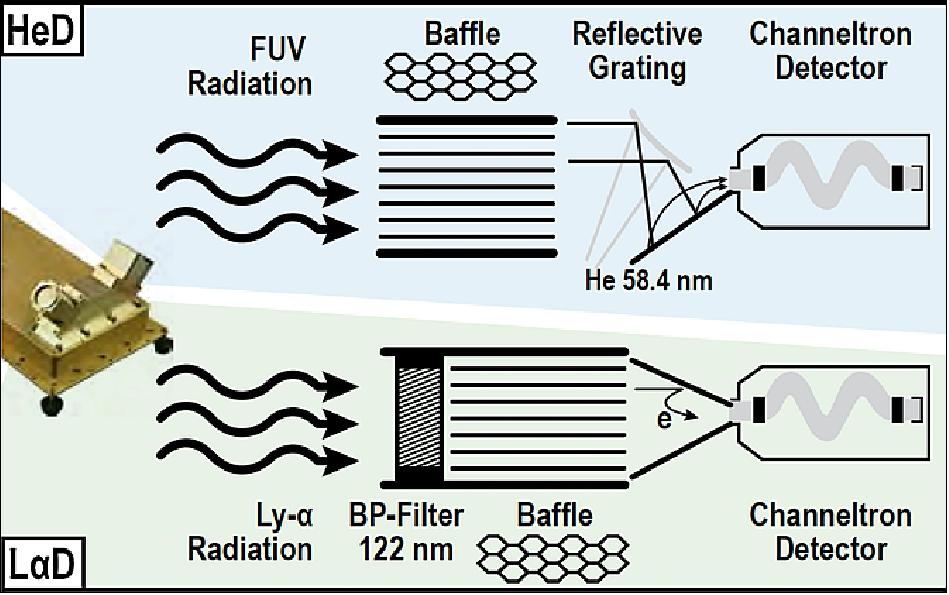
GLOWS measures the modulation of the backscatter glow as a function of IMAP spin angle and its evolution during the Earth's travel around the Sun and with the changing solar activity (Figure 24). The angular radii of the scanning circles of the two detectors are carefully selected so that the lines of sight intersect the solar polar axis in the geometric location where the respective maximum emissivity regions for the Lyman-α and He58.4 nm glows are located. The distribution of the Lyman-α glow around the Sun reflects the latitudinal structure of the solar wind, existing because of the strong dependence of the charge-exchange ionization rate on the solar wind flux, which varies with heliolatitude. The distribution of the helium glow within ~30º from the Sun reflects ionization of ISN He by solar wind electron im-pact. With the solar wind structure known from Lyman-α measurements, observations of the modulation of the He 58.4 nm signal for the first time establish the temperature of solar wind electrons close to the Sun at all heliolatitudes, which is fundamental to understanding the energy transport in the electron fluid near the Sun. In addition, observation of the helium glow, especially in March and September, establish the latitude of the flow direction of ISN helium because of the heliotail visibility, without interference from the Earth's exospheric glow.
The LαD and HeD detectors operate in synergy and provide a sufficient angular and time resolution to observe weekly variations of the solar wind structure and electron temperature. They also assist the determination of the interstellar He flow direction through the heliosphere. The extra-heliospheric (astrophysical) light sources will enable in-flight calibration and the inevitable sensitivity reduction tracing.
Development Status
• August 17, 2021: NASA has given Princeton University, the Johns Hopkins Applied Physics Laboratory (APL) and their many partner institutions the go-ahead to begin implementing the Interstellar Mapping and Acceleration Probe (IMAP) — a mission to sample, analyze and map particles streaming to Earth from the edges of interstellar space. 8)
- Set to launch in February 2025, IMAP will investigate two critical issues in space physics: the acceleration of energetic particles from the Sun and the interaction of these particles — known as the solar wind — with the interstellar medium. The solar-powered spacecraft will be positioned about one million miles (1.5 million km) away from Earth and toward the Sun at what is called the first Lagrange point, where it can monitor the interactions between the solar wind and the interstellar medium in the outer solar system.
- In May, the IMAP team underwent a preliminary design review, covering topics such as spacecraft design, mission requirements, science plans, schedule and costs. Held at APL, which manages the mission and will build and operate the IMAP spacecraft, the review included a panel of external experts tasked with evaluating the information and assessing mission progress for NASA. Following a subsequent meeting, the team received confirmation from NASA on July 12 to proceed to the next stage of development, which includes the detailed, final spacecraft and mission design.
- "This review was a significant step forward," said Princeton University astrophysics professor David McComas, who, as IMAP principal investigator, leads the mission and its international team of 24 partner institutions. "The team has worked very hard to show that we are on track to meet the cost, schedule and technical requirements of a challenging mission, and the reviewers recognized that."
- Carrying 10 science instruments provided by international and domestic research organizations and universities, IMAP will help researchers better understand the boundary of the heliosphere, the magnetic "bubble" surrounding and protecting our solar system. It's here where the constant flow of the solar wind collides with material from the rest of the galaxy. This collision limits the amount of harmful cosmic radiation entering the heliosphere, and by collecting and analyzing the particles that make it through, IMAP will reveal just how the heliosphere filters cosmic rays.
- The mission also aims to learn more about the generation of cosmic rays in the heliosphere; these particles pose risks to astronauts and technological systems, but they may also play a role in the formation and presence of life in the universe.
- "With science and engineering expertise from around the world, the IMAP team has a deep experience in missions designed to examine, in depth, the Sun's effects on our solar system and the space beyond," said Joe Westlake, the IMAP project scientist from APL. "We're excited to fine-tune the designs on a spacecraft and mission that will deliver unprecedented science."
- IMAP is the fifth mission in NASA's Solar Terrestrial Probes (STP) Program portfolio. The Heliophysics Program Office at NASA's Goddard Space Flight Center in Greenbelt, Maryland, manages the STP Program for the agency's Heliophysics Division of NASA's Science Mission Directorate.
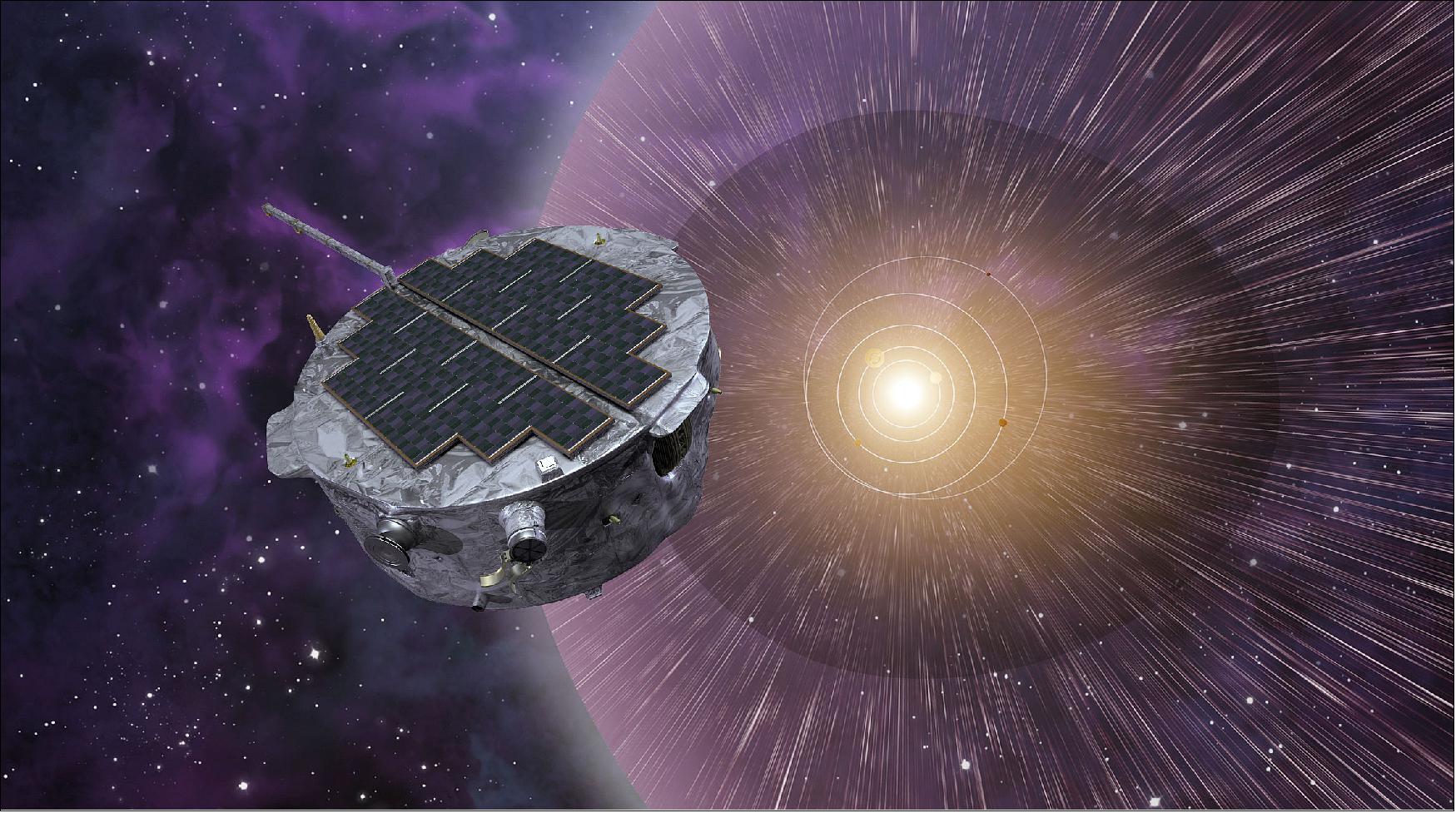
• March 2021: The IMAP mission resolves two major questions in Heliophysics today: The acceleration of energetic particles and the interaction of the solar wind with the interstellar medium. IMAP consists of a spinning observatory operating in a Lissajous orbit about the Sun-Earth Lagrange Point 1 (L1) with a complement of 10 different instruments. Measurements include energetic neutral atom (ENA) imaging of interstellar interactions with the heliosphere, solar wind composition, magnetic fields, heliospheric backscatter glow for in flowing interstellar hydrogen, and interstellar dust. In addition to primary science, IMAP contributes to space weather with continuous near-real-time transmission of a subset of the science data. 9)
- The mission launches in February 2025 from Cape Canaveral Air Force Station on a near escape trajectory with backup launch periods available every month. IMAP will cruise for 3.6 months after which it will insert into a 9.5 x3.9 deg orbit about L1. During cruise, IMAP will perform any required correction maneuvers and commission the observatory. The primary two-year mission, begins once the operational orbit is achieved. During the operational mission, the observatory makes continuous measurements throughout each day. To accommodate the daily motion of the Earth-Sun line relative to the spinning observatory, IMAP autonomously repoints daily to maintain its spin-axis pointed into the nominal solar wind aberration.
• January 14, 2021: NASA and the Ministry of Science and Higher Education of the Republic of Poland have agreed to cooperate on a NASA heliophysics mission, the Interstellar Mapping and Acceleration Probe (IMAP). The agreement, signed Dec. 30, 2020, will allow the Space Research Center of the Polish Academy of Sciences (CBK PAN) to design and build one of IMAP's 10 instruments — the Global Solar Wind Structure (GLOWS) instrument — as well as provide ground support and personnel necessary to support the instrument and the IMAP science team. 10)
- Scheduled to launch no earlier than February 2025, IMAP will observe and map the Sun's heliosphere — the volume of space filled with particles streaming out from the Sun, known as the solar wind — and study how it interacts with the local galactic neighborhood beyond. The boundary zone at the edge of the heliosphere offers protection from the harsher radiation of interstellar space; it may have played a role in creating a habitable solar system and is critical in NASA's plans for safe human exploration of the Moon and Mars.
- GLOWS will help chart Earth's astronomical neighborhood by observing light bouncing off hydrogen within interplanetary space. Detecting this glow reveals information about variations in the hydrogen-rich solar wind pouring off of the Sun and helps identify hydrogen that has arrived from interstellar space.
- This is the first time Poland will build an entire instrument for NASA, continuing a long previous history of working together.
- "This agreement builds on a history of cooperation with Poland that dates back to 1962," said NASA Associate Administrator Steve Jurczyk. "We appreciate Poland's support for IMAP, and together we'll work to explore and understand our space environment better than ever before."
- The agreement expands NASA's cooperation with Poland from its two ongoing Earth science activities to heliophysics, the study of the Sun and how it drives a dynamic space environment that can affect astronauts and technology in space. In addition to studying the fundamental nature of our solar system, IMAP will enable and mature new ways of forecasting space weather by streaming real-time observations of Earth's space environment to operators on the ground.
- "The Space Research Center of the Polish Academy of Sciences has been conducting research into the heliosphere for many years now," said Jerzy Duszyński, the president of the Polish Academy of Science. "The invitation it has received to cooperate with NASA confirms the highest standard of space research at the Polish Academy of Sciences."
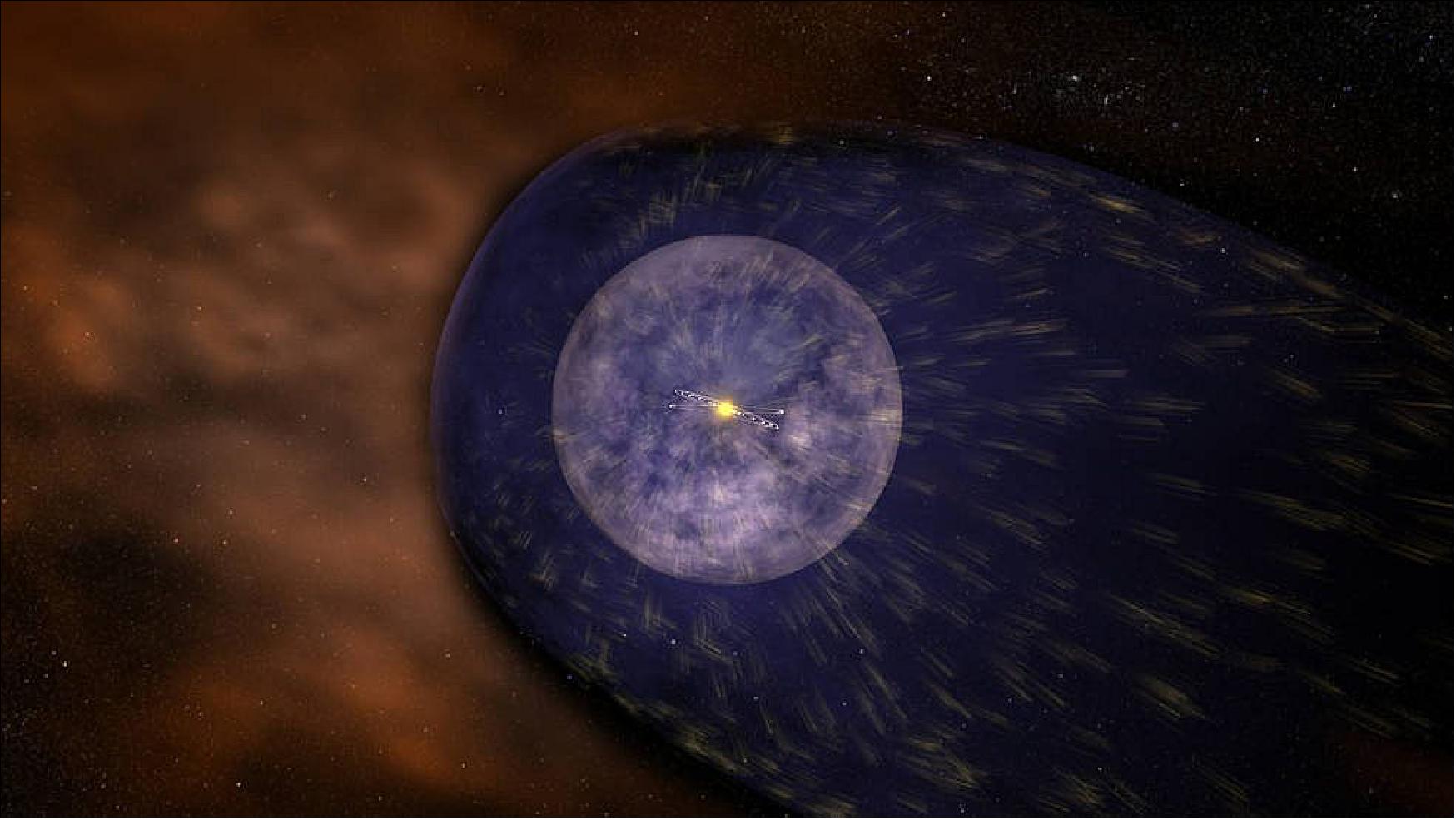
- "I have worked closely for almost two decades with our colleagues in Poland," said David J. McComas, the principal investigator for IMAP and a professor at Princeton University in New Jersey. "I am delighted that they will be building this instrument as a part of the IMAP mission. Their contributions to the team are invaluable and I welcome this formal recognition of the relationship between us."
- McComas leads the IMAP mission and an international team of 24 partner institutions. The Johns Hopkins Applied Physics Laboratory in Laurel, Maryland, will build the IMAP spacecraft and operate the mission for NASA. IMAP is the fifth mission in NASA's Solar Terrestrial Probes (STP) Program portfolio. The Heliophysics Program Office at NASA's Goddard Space Flight Center in Greenbelt, Maryland, manages the STP Program for the Heliophysics Division of NASA's Science Mission Directorate.
• December 3, 2020: NASA has selected two SmallSat missions – a study of Earth's outer most atmosphere and a solar sail spaceflight test mission – to share a ride to space in 2025 with the agency's Interstellar Mapping and Acceleration Probe (IMAP). 11)
- The missions – the Global Lyman-alpha Imagers of the Dynamic Exosphere (GLIDE) and Solar Cruiser – were selected as Solar Terrestrial Probes (STP) Missions of Opportunity. GLIDE will help researchers understand the upper reaches of Earth's atmosphere – the exosphere – where it touches space. The Solar Cruiser is to demonstrate the use of solar photons for propulsion in space.
- The launch of the IMAP mission in 2025 to the first Lagrangian equilibrium point (L1), about 1 million miles towards the Sun, will be a pathfinder for NASA's new RideShare policy. With the policy, the agency's Science Mission Directorate (SMD) will plan – from the inception of major missions – to take advantage of excess launch capacity and provide increased access to space for SmallSats. IMAP will help researchers better understand the interstellar boundary region, where the solar wind and the solar magnetic field it transfers to the edge of the solar system collide with galactic material and the galactic magnetic field.
- Focusing on small satellites and tech demonstrations helps prove the capabilities of these smaller missions and pairing them with existing missions for launch provides more avenues for learning about the solar system and developing innovative technical capabilities.
- "The study of the solar influence on interplanetary space and the area around our Earth has made great advances just in the past decade," said Thomas Zurbuchen, associate administrator for science at NASA Headquarters in Washington. "I'm confident the next decade promises even more new discoveries and historic technology innovations."
- The science selection was made competitively from proposals to help better understand the fundamental nature of space and the interaction between space and Earth's environment. As the selected science mission, GLIDE will study variability in Earth's exosphere by tracking far ultraviolet light emitted from hydrogen. The exosphere is the outer region of Earth's atmosphere that touches space – a region where atoms can escape Earth. Observing the global structure of the exosphere requires a telescope that is outside of the outer reaches of the atmosphere, which extend almost to the Moon. The IMAP launch trajectory to the inner Lagrangian point, the point of the Earth-Sun system that provides an uninterrupted view of the Sun, will provide just such a perspective for the GLIDE mission and is ideally suited for the first continuous observations of the exosphere and its variations in response to solar storm disruptions.
- GLIDE will fill a measurement gap, as only a handful of comparable ultraviolet light images have previously been made from outside the exosphere. The mission will gather observations at a high rate, with a view of the entire exosphere, ensuring a global and comprehensive set of data. Understanding the ways in which Earth's exosphere changes in response to influences of the Sun above or the atmosphere below, will provide us with better ways to forecast and, ultimately, mitigate the ways in which space weather can interfere with radio communications in space.
- The principal investigator for GLIDE is Lara Waldrop at the University of Illinois at Urbana-Champaign. The GLIDE investigation is budgeted for $75 million.
- Solar Cruiser was selected as the technology demonstration mission. Consisting of a nearly 18,000-square-foot (nearly 1,700 m2) solar sail, it will demonstrate the ability to use solar radiation as a propulsion system. Such a system could provide access to new orbits enabling high-value science, including SmallSat observations from deep space, out of the ecliptic plane, and in stationary orbits in the Earth's geo-tail. Solar Cruiser will demonstrate one such orbit, where a spacecraft maintains position along the Earth-Sun line at a point closer to the Sun than L1. By positioning a monitoring spacecraft closer to the Sun, space weather scientists hope to obtain more advanced warnings of solar storms headed to Earth.
- The principal investigator for Solar Cruiser is Les Johnson at NASA's Marshall Space Flight Center in Huntsville, Alabama. The Solar Cruiser investigation is budgeted for $65 million.
- A second STP science Mission of Opportunity, the Spatial/Spectral Imaging of Heliospheric Lyman Alpha (SIHLA), also was provided funding toward a final selection decision at a later date based on budget and RideShare opportunities. SIHLA would use an innovative technique to map the entire sky to determine the shape and underlying mechanisms of the boundary between the heliosphere, the area of our Sun's magnetic influence, and the interstellar medium, a boundary known as the heliopause.
- "Launching several missions together helps us maximize science while keeping costs down," said Nicky Fox, Heliophysics Division director at NASA Headquarters in Washington. "We're expanding the range and composition of a robust fleet of missions studying the Sun and space weather, and these two new selections will help advance into areas where we need to know more."
- From the start of IMAP mission formulation, SMD planned to include secondary spacecraft on the launch under the agency's SMD Rideshare Initiative, which cuts costs by sending multiple missions on a single launch. This launch will also include the National Oceanic and Atmospheric Administration's (NOAA) Space Weather Follow-On mission, which will expand that agency's space weather forecasting.
- "Expanding our capabilities and knowledge through experimental missions using SmallSats and tech demos enables us to do and try so many more things," said Peg Luce, deputy director of the Heliophysics Division at NASA Headquarters in Washington. "Our Sun has thrown a lot of interesting questions at us lately, and we're using every avenue to study space weather and its impact on our planet and our solar system."
- Funding for these missions comes from the Heliophysics Solar Terrestrial Probes (STP) program, which is managed by NASA's Goddard Space Flight Center in Greenbelt, Maryland.
• September 25, 2020: NASA has selected Space Exploration Technologies (SpaceX) of Hawthorne, California, to provide launch services for the agency's Interstellar Mapping and Acceleration Probe (IMAP) mission, which includes four secondary payloads. IMAP will help researchers better understand the boundary of the heliosphere, a magnetic barrier surrounding our solar system. This region is where the constant flow of particles from our Sun, called the solar wind, collides with winds from other stars. This collision limits the amount of harmful cosmic radiation entering the heliosphere. IMAP will collect and map neutral particles that make it through, as well as investigate the fundamental processes of how particles are accelerated in space, from its vantage point orbiting the Sun at the Lagrange 1 point directly between the Sun and Earth. 12)
- The total cost for NASA to launch IMAP and the secondary payloads is approximately $109.4 million, which includes the launch service and other mission related costs.
- The secondary payloads to be included with the launch of IMAP are: NASA's Lunar Trailblazer mission, two additional NASA heliophysics missions of opportunity yet to be named, and the National Oceanic and Atmospheric Administration's Space Weather Follow On-Lagrange 1 (SWFO-L1) mission.
- The IMAP mission is targeted to launch in October 2024 on a Falcon 9 Full Thrust rocket from Launch Complex 40 at Cape Canaveral Air Force Station in Florida.
- NASA's Launch Services Program at the agency's Kennedy Space Center in Florida will manage the SpaceX launch service. The mission is led by Princeton University in New Jersey, in partnership with Johns Hopkins Applied Physics Laboratory in Laurel, Maryland. NASA's Goddard Space Flight Center in Greenbelt, Maryland, is responsible for the mission's overall management, system engineering, integration, and testing and mission operations.
• January 28, 2020: A mission to study the interaction of the solar wind with the ancient cast-off winds of other stars, and the fundamental process of particle acceleration in space, has completed a critical NASA review and is now moving closer toward a scheduled launch in 2024. SwRI (Southwest Research Institute) is playing a major role in the IMAP (Interstellar Mapping and Acceleration Probe) spacecraft, managing the payload office and providing a scientific instrument and other technology for the mission. 13)
- The IMAP mission completed its Key Decision Point-B review on 28 January 2020, which now allows the IMAP team to move forward with preliminary design work on the mission, spacecraft, and instruments, referred to as Phase B. Phase B will officially begin on Jan. 28.
- "This is a big milestone for the IMAP mission as we move out of the architecting phase into the design phase," said David McComas, IMAP principal investigator and Princeton University Vice President for the Princeton Plasma Physics Laboratory. "IMAP is a critical new mission of exploration and discovery about the heliosphere—our home in space—and this is a critical step forward in it."
- A focus for IMAP is to explore the very boundaries of the heliosphere—the space filled with plasma from the Sun that envelops all the planets of the solar system—to interstellar space. Here the outpouring of solar material collides with the local interstellar medium that fills the space surrounding the heliosphere. This interaction forms a critical barrier for high-energy cosmic rays, at a distance of about 10 billion miles from the Sun.
- SwRI is managing the payload and payload systems engineering, providing a scientific instrument and supporting the development of other IMAP technology for the mission.
- "SwRI is providing IMAP's CoDICE (Compact Dual Ion Composition Experiment), which combines the capabilities of multiple instruments into one patented sensor about the size of a 5-gallon paint bucket and weighing about 22 pounds," said Dr. Mihir Desai, director of the SwRI Space Research Department and an IMAP co-investigator. "Initially developed with internal SwRI funding, CoDICE will measure the distributions and composition of interstellar pickup ions, particles that make it through the 'heliospheric' filter. It also characterizes solar wind ions as well as the mass and composition of highly energized particles from the Sun."
- During Phase A of the IMAP mission, scientists and engineers reviewed and finalized plans for the ten scientific instruments, seven of which will directly sample matter from the interstellar medium that reaches Earth's vicinity. These samples include interstellar neutral atoms and ions picked up and accelerated by the solar wind, but also dust particles of interstellar origin.
- IMAP will also examine the fundamental processes that accelerates particles throughout the heliosphere and beyond; the resulting energetic particles and cosmic rays can harm astronauts and space-based technologies.
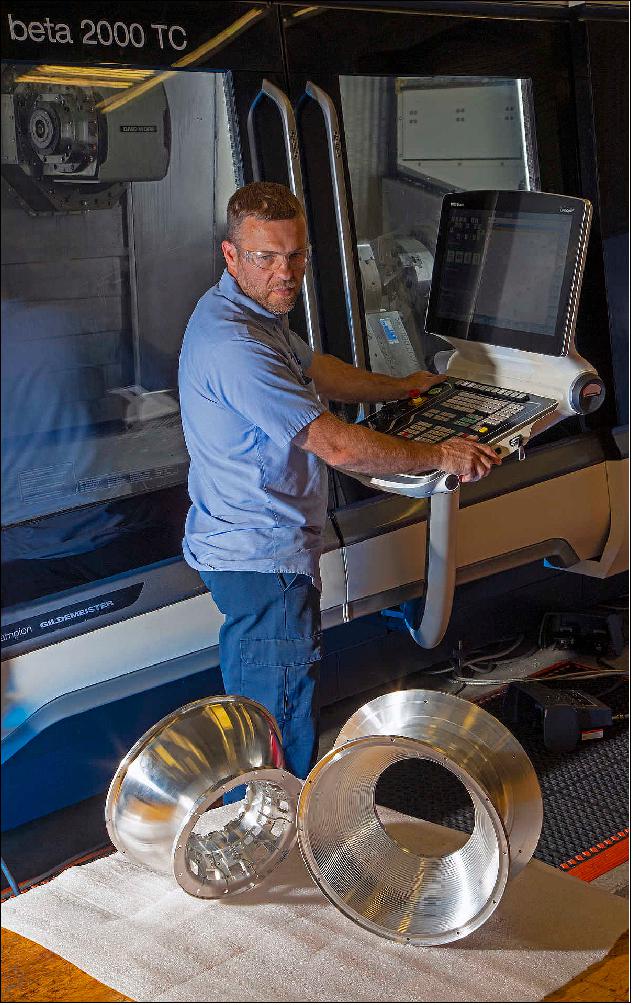
- "SwRI is also contributing to the development of the next-generation energetic neutral atom imagers as well as electronics to support IMAP instruments that measure solar wind electrons," said Susan Pope, director of the Space Instrumentation Department and IMAP payload systems engineer.
- "IMAP will help us understand how our Sun and the solar wind affect the boundary of our solar system," said SwRI Program Director John Scherrer, IMAP payload manager.
- By studying the nature of the interaction of solar and stellar winds, IMAP will join a fleet of NASA heliophysics missions seeking to understand how the Sun affects the space environment near Earth and across the solar system. Heliophysics spacecraft studying the Sun, near-Earth space, and the boundaries of the heliosphere form a system observatory. Understanding the basic fundamental processes that govern our neighborhood in space continues to build a foundation for prediction of Earth's and the solar system's space weather.
- In addition to maturing the design of the mission, IMAP's Phase B will encompass the construction of subassemblies and instrument elements, and the choice of additional hardware and subsystem partners and vendors. IMAP was selected following a competitive peer review of proposals submitted in late 2017. The mission is cost-capped at $564 million, excluding cost for the launch vehicle.
• August 13, 2019: NASA has selected two proposals for concept studies that could help us better understand the fundamental nature of space and how it changes in response to planetary atmospheres, radiation from the Sun, and interstellar particles. The proposals will advance NASA's heliophysics program and could lead to better protection for both technology and humans as we travel farther from home. 14)
- Each of these Heliophysics Science Mission of Opportunity proposals will receive $400,000 to conduct a nine-month mission concept study. After the studies, NASA will choose one proposal to launch as a secondary payload on the agency's Interstellar Mapping and Acceleration Probe (IMAP).
- The proposals were selected based on potential science value and feasibility of development plans. Total cost of this Mission of Opportunity is capped at $75 million and is funded by NASA's Solar Terrestrial Probes program.
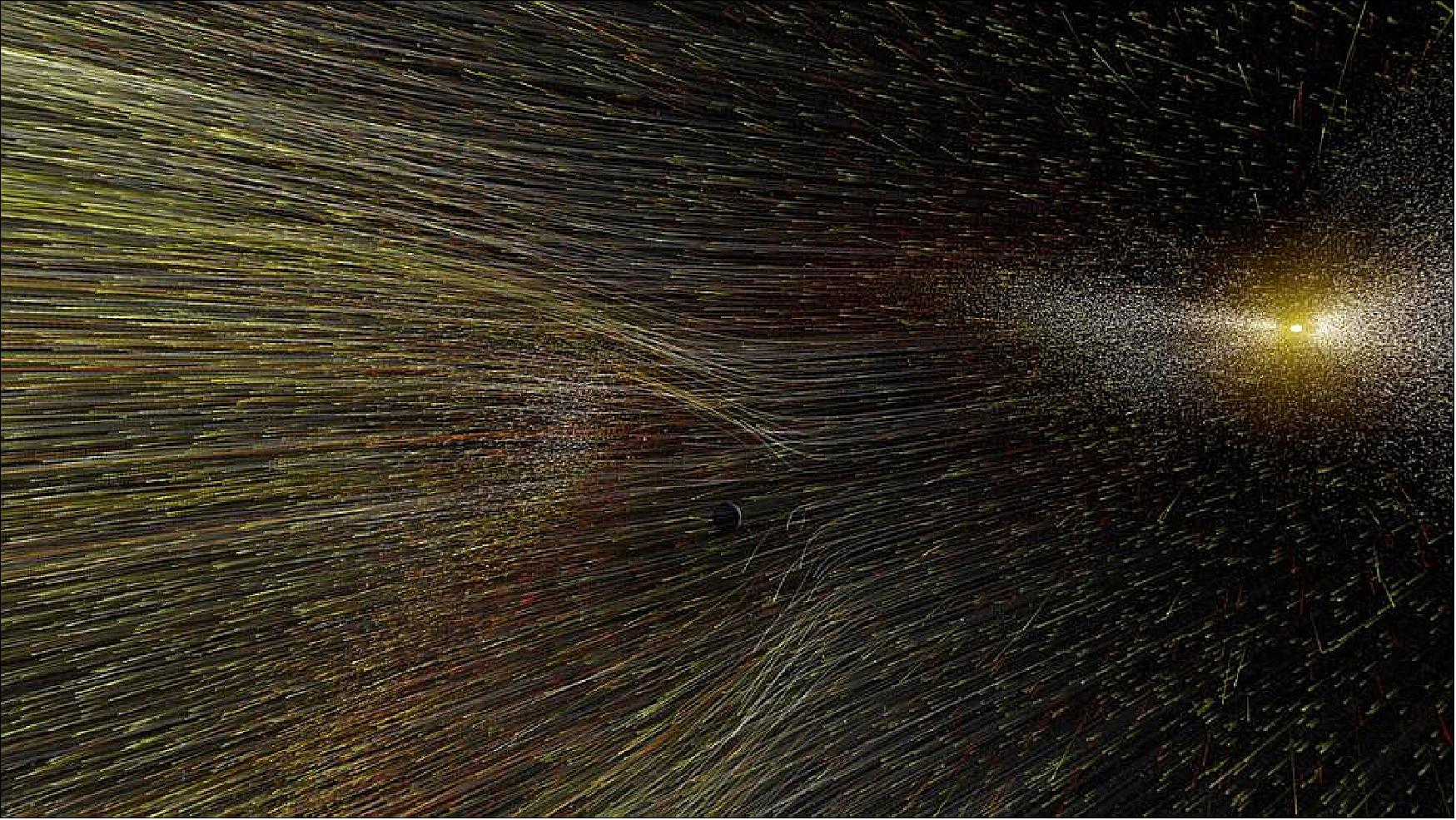
The selected proposals are:
1) Spatial/Spectral Imaging of Heliospheric Lyman Alpha (SIHLA)
SIHLA would map the entire sky to determine the shape and underlying mechanisms of the boundary between the heliosphere, the area of our Sun's magnetic influence, and the interstellar medium, a boundary known as the heliopause. The observations would gather far-ultraviolet light emitted from hydrogen atoms. This wavelength is key for examining many astrophysical phenomena, including planetary atmospheres and comets, because so much of the universe is composed of hydrogen. SIHLA will focus on mapping the velocity and distribution of the solar wind – the outpouring of particles from the Sun – helping to resolve our understanding of what drives structure in the solar wind and heliopause. This is an area of research undergoing rapid evolution due to data from NASA missions, such as Voyager, Parker Solar Probe and Interstellar Boundary Explorer.
The principal investigator for SIHLA is Larry Paxton at the Johns Hopkins University Applied Physics Laboratory in Laurel, Maryland.
2) Global Lyman-alpha Imagers of the Dynamic Exosphere (GLIDE)
The GLIDE mission would study variability in Earth's exosphere, the uppermost region of its atmosphere, by tracking far ultraviolet light emitted from hydrogen. The proposed mission would fill an existing measurement gap, as only a handful of such images previously have been made from outside the exosphere. The mission would gather observations at a high rate, with a view of the entire exosphere, ensuring a truly global and comprehensive set of data. Understanding the ways in which Earth's exosphere changes in response to influences of the Sun above or the atmosphere below, would provide us with better ways to forecast and, ultimately, mitigate the ways in which space weather can interfere with radio communications in space.
The principal investigator for GLIDE is Lara Waldrop at the University of Illinois, Champaign-Urbana.
- IMAP currently is scheduled to launch in October 2024 to orbit a point between Earth and the Sun known as the first Lagrangian point, or L1. From there, IMAP will help researchers better understand the interstellar boundary region, where particles from the Sun collide with material from the rest of the galaxy. This distant area controls the amount of harmful cosmic radiation entering the heliosphere, the magnetic bubble that shields our solar system from charged particles surrounding it. Cosmic rays from the galaxy and beyond affect astronauts and can harm technological systems. They also may play a role in the presence of life in the universe.
- From the start of IMAP mission formulation, NASA's Science Mission Directorate (SMD) planned to include secondary spacecraft on the launch under the agency's new SMD Rideshare Initiative, which cuts costs by sending multiple missions on a single launch. This launch will also include a Heliophysics Technology Demonstration Mission of Opportunity – which will be announced separately – to test technologies that can enable future science missions, and the National Oceanic and Atmospheric Administration's (NOAA) Space Weather Follow-On mission, which will expand that agency's space weather forecasting capabilities.
- "Launching missions together like this is a great way to ensure maximum science return while keeping costs low," said Peg Luce, deputy director of NASA's Heliophysics Division. "We carefully select new heliophysics spacecraft to complement the well-placed spacecraft NASA has in orbit to study this vast solar wind system – and our rideshare initiative increases our opportunities to send such key missions into space" (Ref. 14).
• June 1, 2018: NASA has selected a science mission planned for launch in 2024 that will sample, analyze, and map particles streaming to Earth from the edges of interstellar space. 15)
- The Interstellar Mapping and Acceleration Probe (IMAP) mission will help researchers better understand the boundary of the heliosphere, a sort of magnetic bubble surrounding and protecting our solar system. This region is where the constant flow of particles from our Sun, called the solar wind, collides with material from the rest of the galaxy. This collision limits the amount of harmful cosmic radiation entering the heliosphere. IMAP will collect and analyze particles that make it through.
- "This boundary is where our Sun does a great deal to protect us. IMAP is critical to broadening our understanding of how this ‘cosmic filter' works," said Dennis Andrucyk, deputy associate administrator for NASA's Science Mission Directorate in Washington. "The implications of this research could reach well beyond the consideration of Earthly impacts as we look to send humans into deep space."
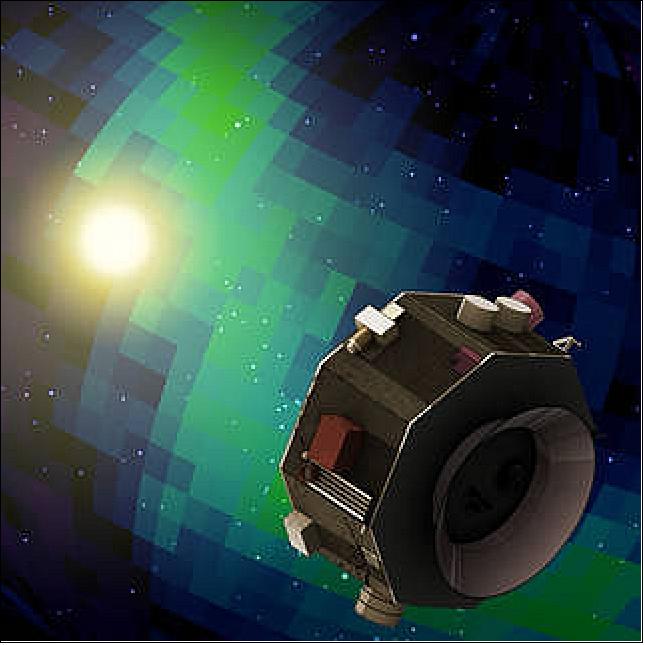
- Another objective of the mission is to learn more about the generation of cosmic rays in the heliosphere. Cosmic rays created locally and from the galaxy and beyond affect human explorers in space and can harm technological systems, and likely play a role in the presence of life itself in the universe.
- The spacecraft will be positioned about one million miles (1.5 million kilometers) away from Earth towards the Sun at what is called the first L1 (Lagrange point). This will allow the probe to maximize use of its instruments to monitor the interactions between solar wind and the interstellar medium in the outer solar system.
- The mission's principal investigator is David McComas of Princeton University. The Johns Hopkins University's Applied Physics Laboratory in Laurel, Maryland, will provide project management. The mission will carry 10 science instruments provided by international and domestic research organizations and universities.
- IMAP was selected following an extensive and competitive peer review of proposals submitted in late 2017. The mission is cost-capped at $492 million, excluding cost for the launch vehicle.
- This is the fifth mission in NASA's Solar Terrestrial Probes (STP) Program portfolio. Others include the Solar Terrestrial Relations Observatory (STEREO), a collaboration with ESA (European Space Agency) that enabled a global view of the Sun and inner heliosphere; the Magnetospheric Multiscale (MMS) mission currently investigating the fundamental process of magnetic reconnection near Earth; the solar remote sensing mission Hinode, an ongoing collaboration with the Japan Aerospace Exploration Agency; and the Thermosphere, Ionosphere, Mesosphere Energetics and Dynamics (TIMED), a mission observing the outermost layers of the Earth's atmosphere.
References
1) "NASA Selects Mission to Study Solar Wind Boundary of Outer Solar System," NASA Release 18-046, 1 June 2018, URL: https://www.nasa.gov/press-release/nasa-selects-mission-to-study-solar-wind-boundary-of-outer-solar-system
2) "SwRI to manage payload, payload systems engineering for IMAP mission," SwRI, 11 June 2018, URL: https://www.swri.org/press-release/swri-manage-payload-systems-engineering-imap-mission
3) D. J. McComas, E. R. Christian, N. A. Schwadron, N. Fox, J. Westlake, F. Allegrini, D. N. Baker, D. Biesecker, M. Bzowski, G. Clark, C. M. S. Cohen, I. Cohen, M.A. Dayeh, R. Decker, G. A. de Nolfo, M. I. Desai, R. W. Ebert,H. A. Elliott, H. Fahr, P. C. Frisch, H. O. Funsten, S. A. Fuselier, A. Galli, A. B. Galvin, J. Giacalone, M. Gkioulidou, F. Guo, M. Horanyi, P. Isenberg, P. Janzen, L. M. Kistler, K. Korreck, M. A. Kubiak, H. Kucharek, B. A. Larsen, R. A. Leske, N. Lugaz, J. Luhmann, W. Matthaeus, D. Mitchell, E. Moebius, K. Ogasawara, D. B. Reisenfeld, J. D. Richardson, C. T. Russell, J. M. Sokó, H. E. Spence, R. Skoug, Z. Sternovsky,P. Swaczyna, J. R. Szalay, M. Tokumaru, M. E. Wiedenbeck, P. Wurz, G. P. Zank, E. J. Zirnstein, "Interstellar Mapping and Acceleration Probe (IMAP): A New NASA Mission," Space Science Review, Vol. 214, https://doi.org/10.1007/s11214-018-0550-1, Published online: 22 October 2018, URL: https://link.springer.com/content/pdf/10.1007%2Fs11214-018-0550-1.pdf
4) D. J. McComas, E. J. Zirnstein, M. Bzowski, H. A. Elliott, B. Randol, N. A. Schwadron, J. M. Sokół, J. R. Szalay,C. Olkin, J. Spencer, A. Stern, H. Weaver, Astrophysical Journal Supplement Series, Vol. 233, No 8, (2017b)
5) "IMAP-Lo," URL: https://imap.princeton.edu/instruments/imap-lo
6) "IMAP-Hi," URL: https://imap.princeton.edu/instruments/imap-hi
7) "IMAP-Ultra," URL: https://imap.princeton.edu/instruments/imap-ultra
8) "IMAP Mission Advances to Next Development Stage," JHU/APL, 17 August 2021, URL: https://www.jhuapl.edu/NewsStory/210817-imap-mission-advances
9) Douglas Eng, John W. Hunt, Sanae Kubota, Dawn Moessner, Daniel A. Ossing, Darrius Pergosky, John R. Scherrer, et al., "Interstellar Mapping and Acceleration Probe Mission Overview," Published in: 2021 IEEE Aerospace Conference (50100), Date of Conference: 06-13 March 2021
10) Karin Fox, Sarah Frazier, "NASA, Poland Sign Agreement to Build Instrument to Study Interplanetary Space," NASA Feature, 14 January 2021, URL: [web source no longer available]
11) Grey Hautaluoma, "NASA Selects Heliophysics Missions of Opportunity for Space Science Research and Technology Demonstration," NASA Press Release 20-120, 3 December 2020, URL: https://www.nasa.gov/press-release/nasa-selects-heliophysics-missions-of-opportunity-for-space-science-research-and
12) Sean Potter, Amanda Griffin,"NASA Awards Launch Services Contract for IMAP Mission," NASA Contract Release C20-026, 25 September 2020, URL: https://www.nasa.gov/press-release/nasa-awards-launch-services-contract-for-imap-mission
13) "NASA's Interstellar Mapping and Acceleration Probe mission enters design phase," SwRI, 28 January 2020, URL: https://www.swri.org/press-release/imap-codice-solar-wind-particle-acceleration
14) Grey Hautaluoma / Karen Fox, "NASA Selects Proposals to Further Study the Fundamental Nature of Space," NASA Press Release 19-067, 13 August 2019, URL: https://www.nasa.gov/press-release/nasa-selects-proposals-to-further-study-the-fundamental-nature-of-space
15) "NASA Selects Mission to Study Solar Wind Boundary of Outer Solar System," NASA Release 18-046, 1 June 2018, URL: https://www.nasa.gov/press-release/nasa-selects-mission-to-study-solar-wind-boundary-of-outer-solar-system
The information compiled and edited in this article was provided by Herbert J. Kramer from his documentation of: "Observation of the Earth and Its Environment: Survey of Missions and Sensors" (Springer Verlag) as well as many other sources after the publication of the 4th edition in 2002. - Comments and corrections to this article are always welcome for further updates (eoportal@symbios.space).
Objectives And Observations Spacecraft Launch Sensor Complement Development Status References